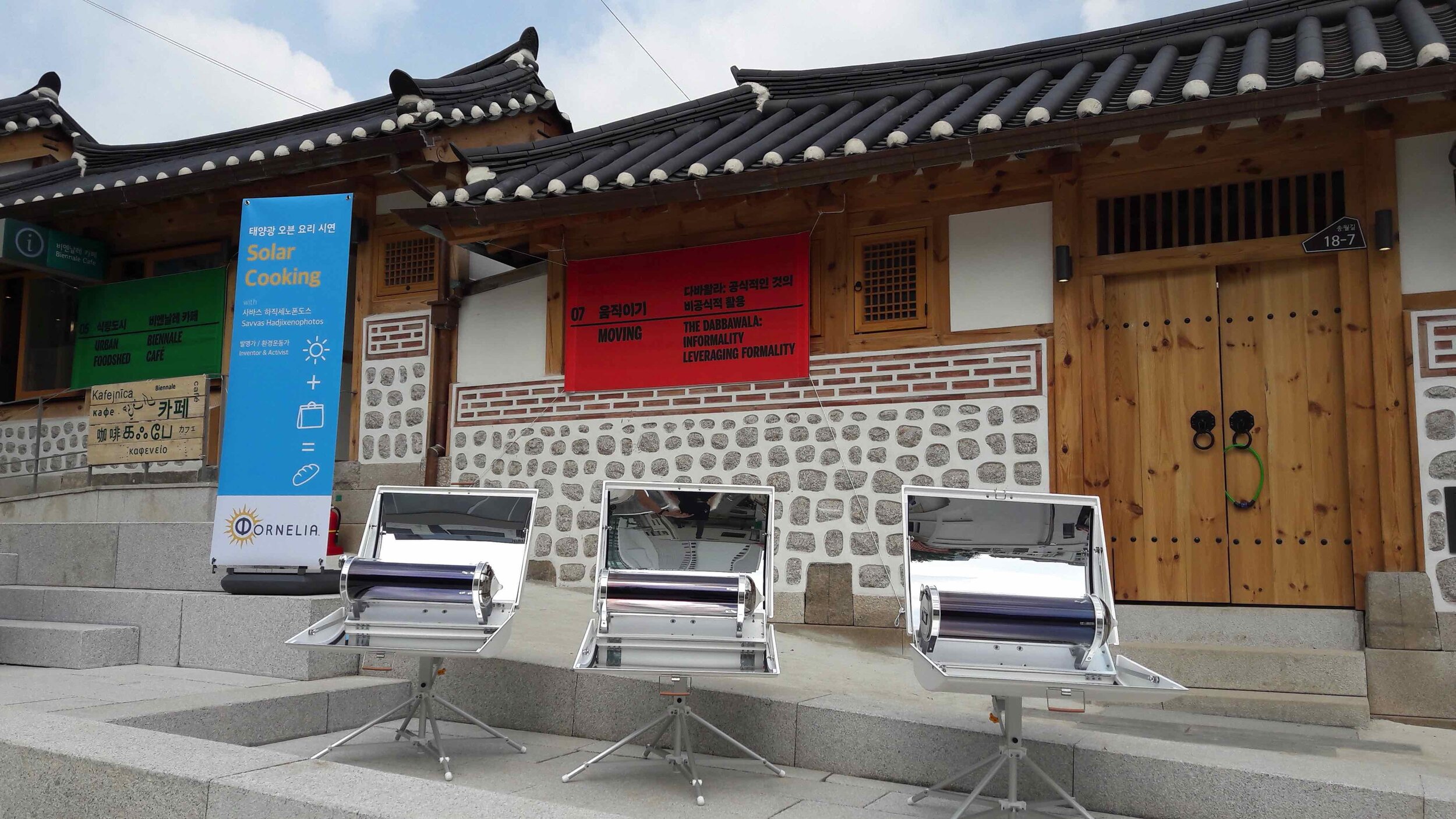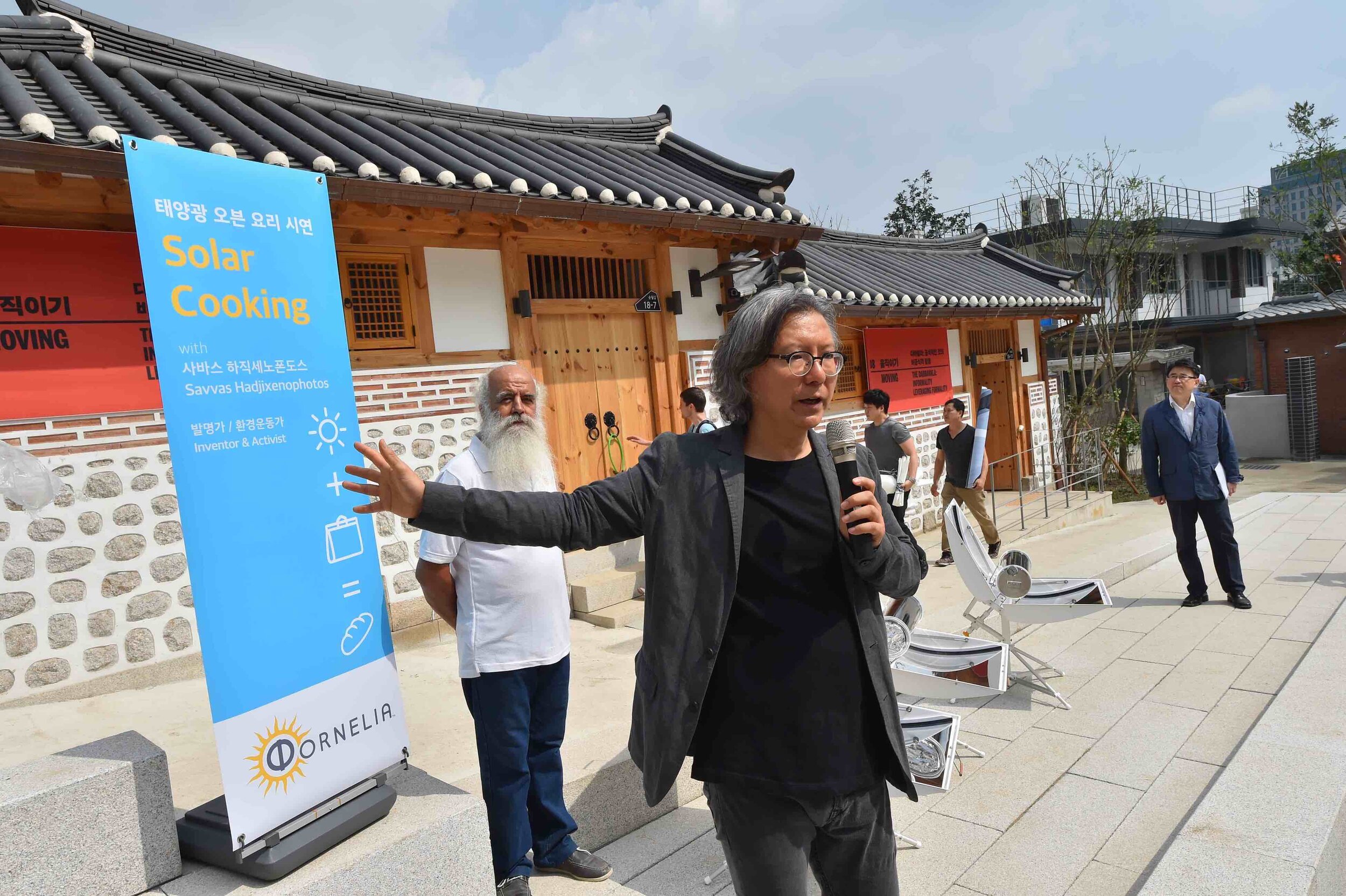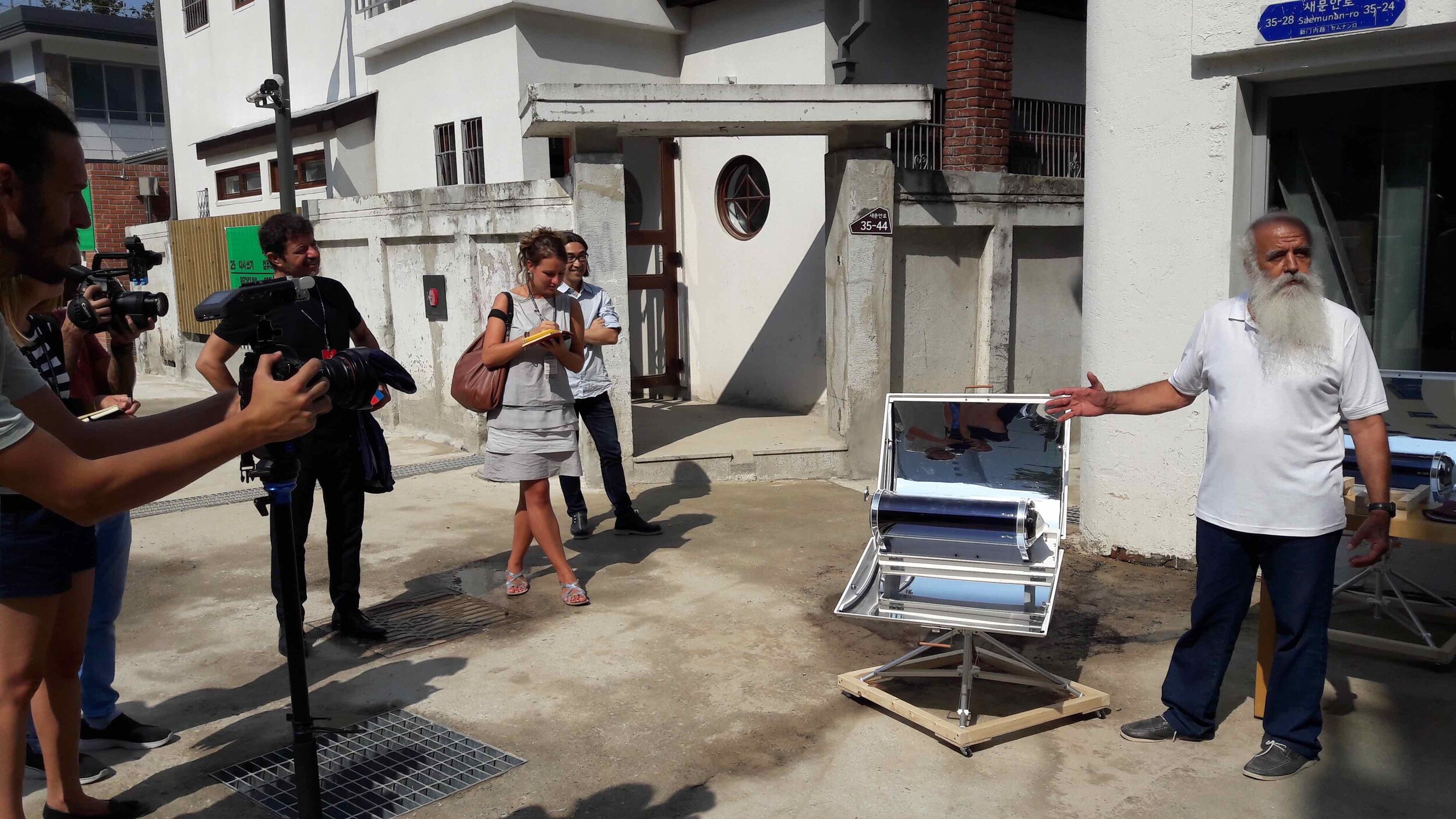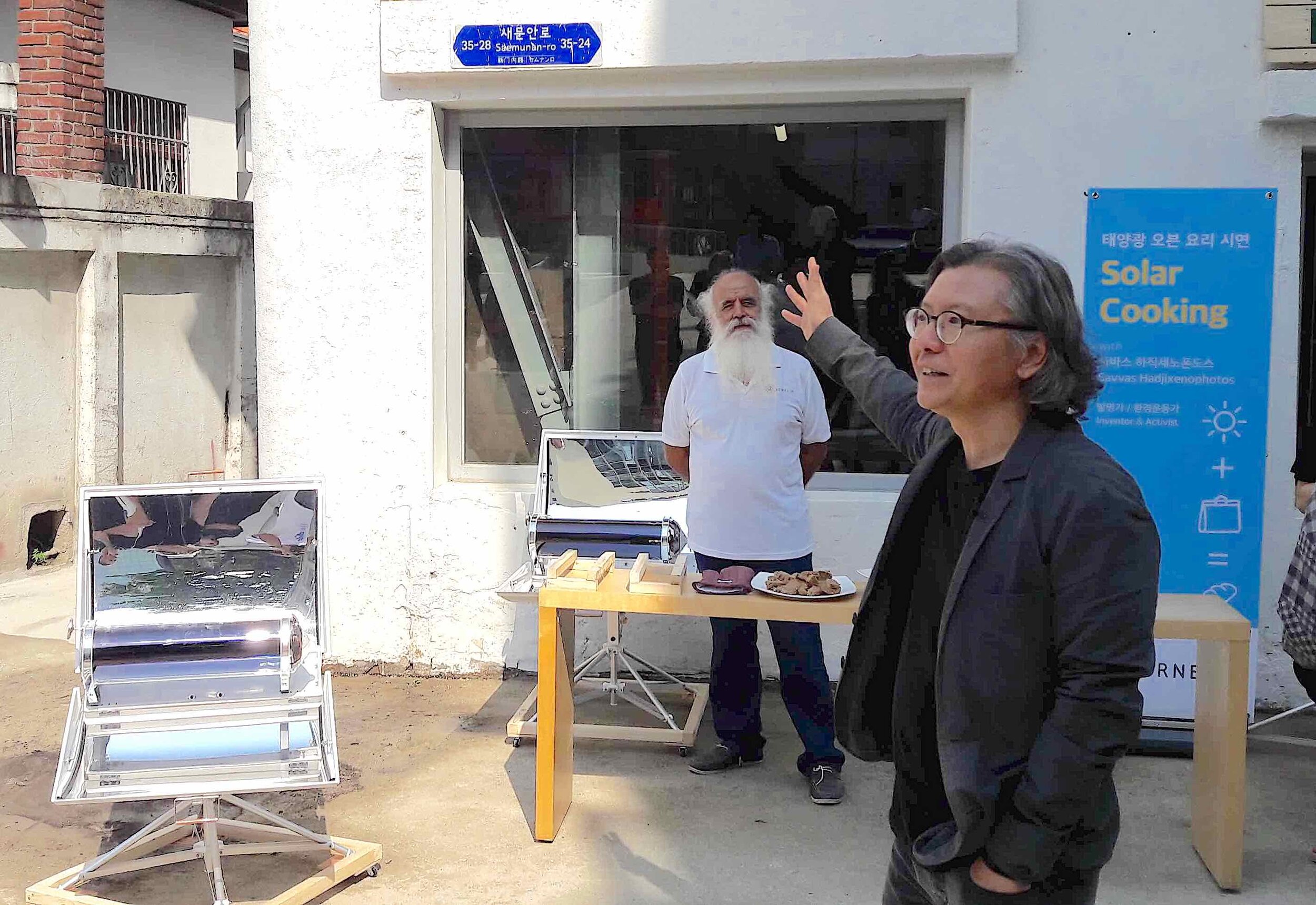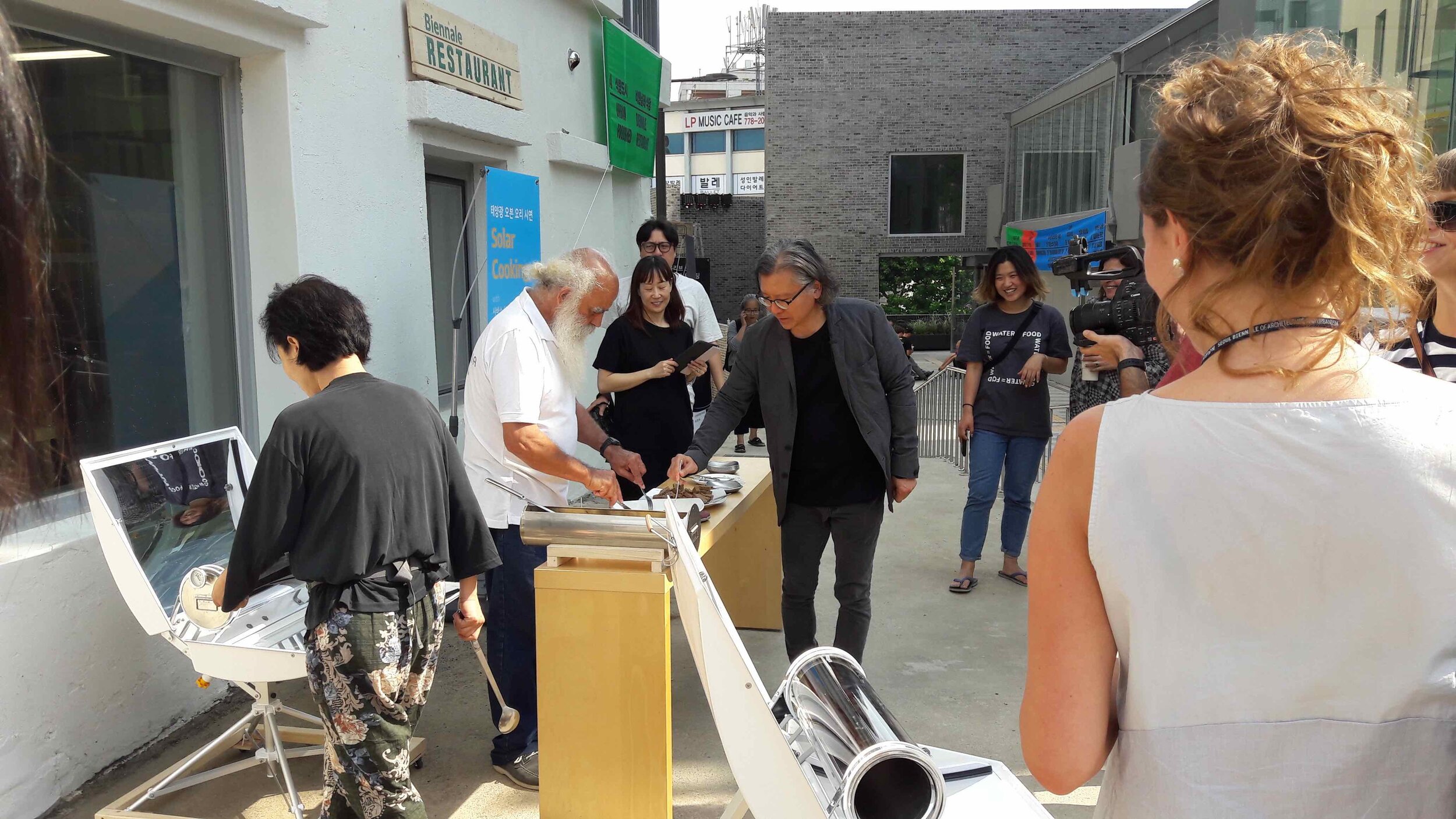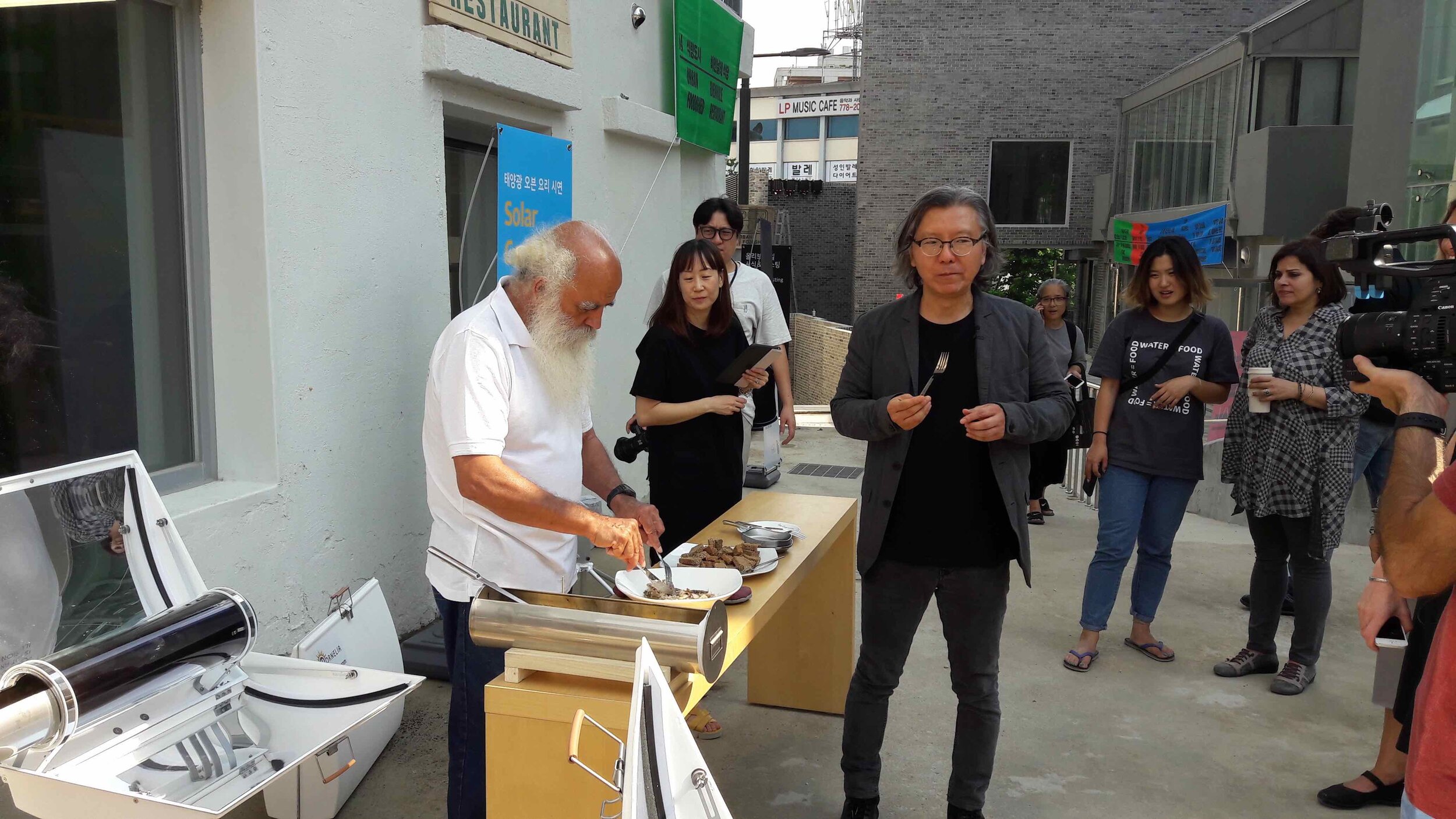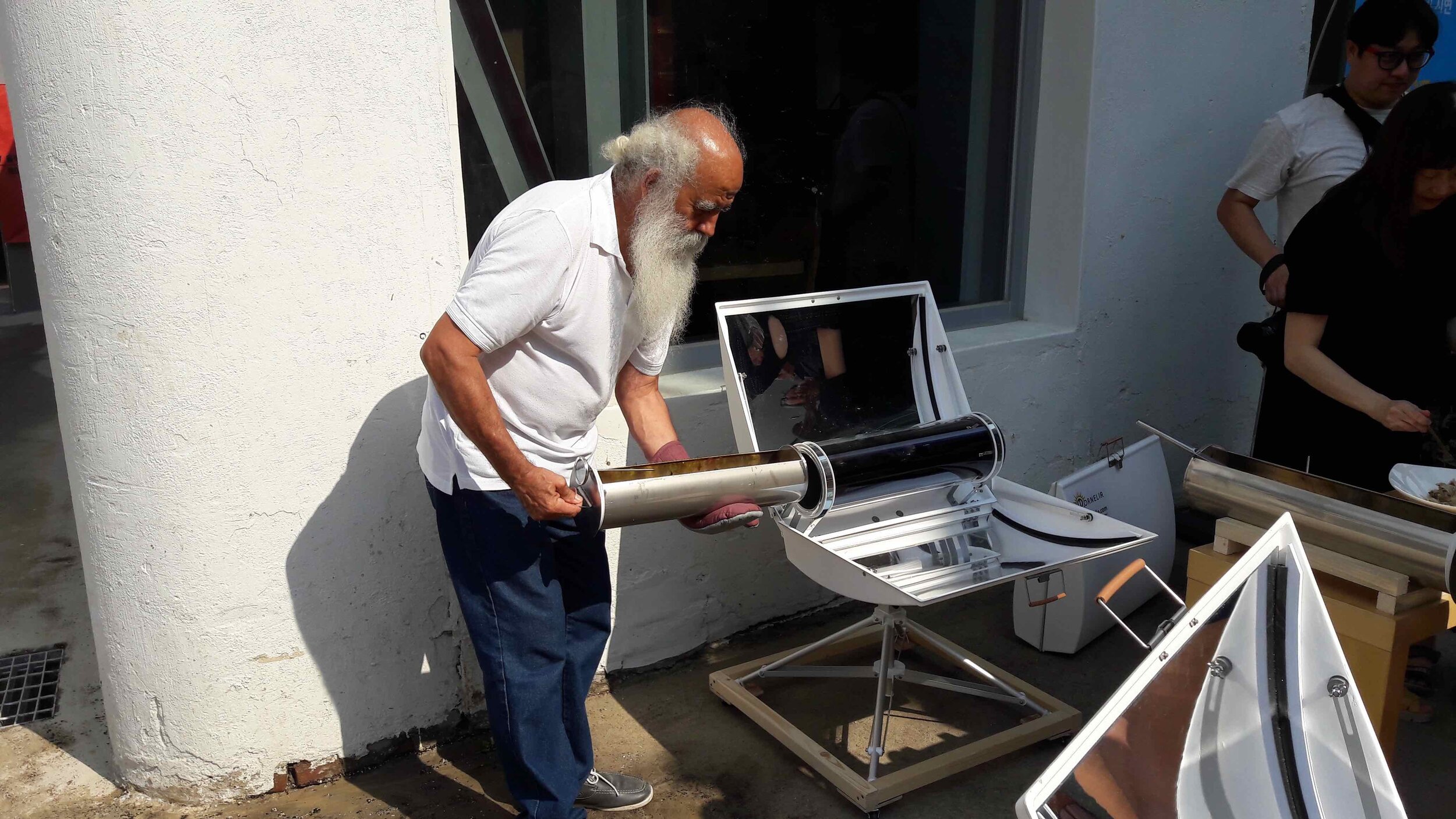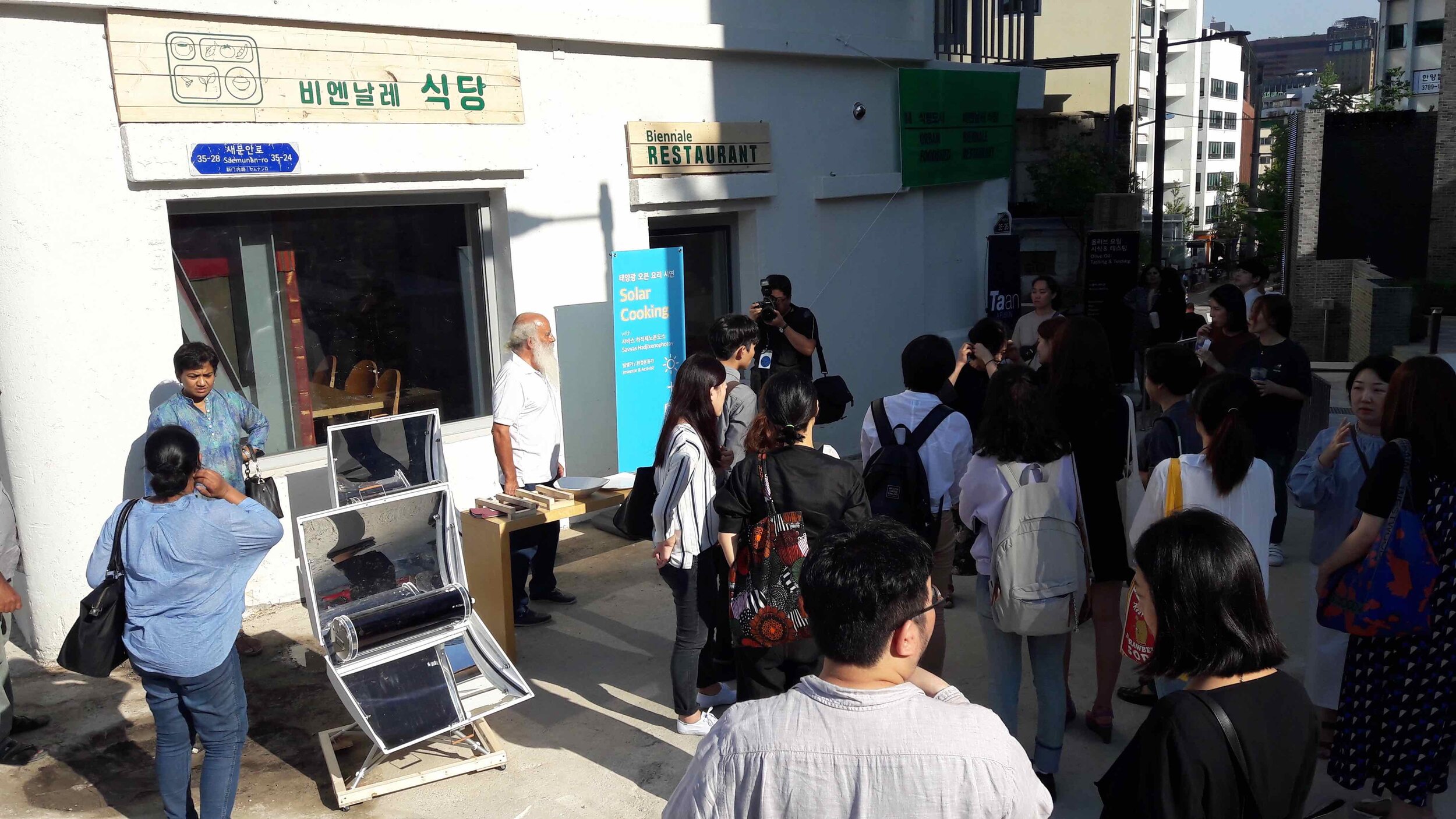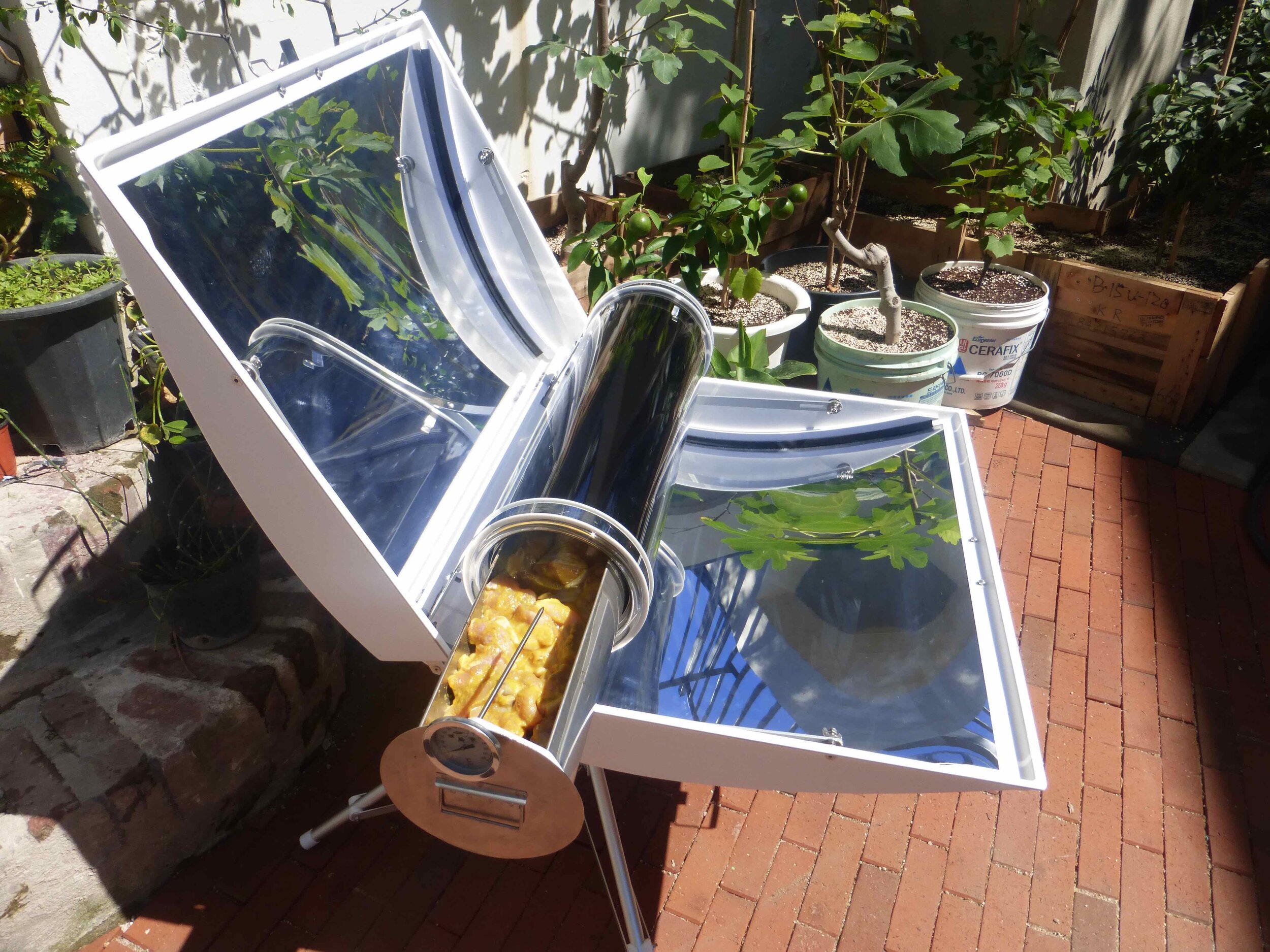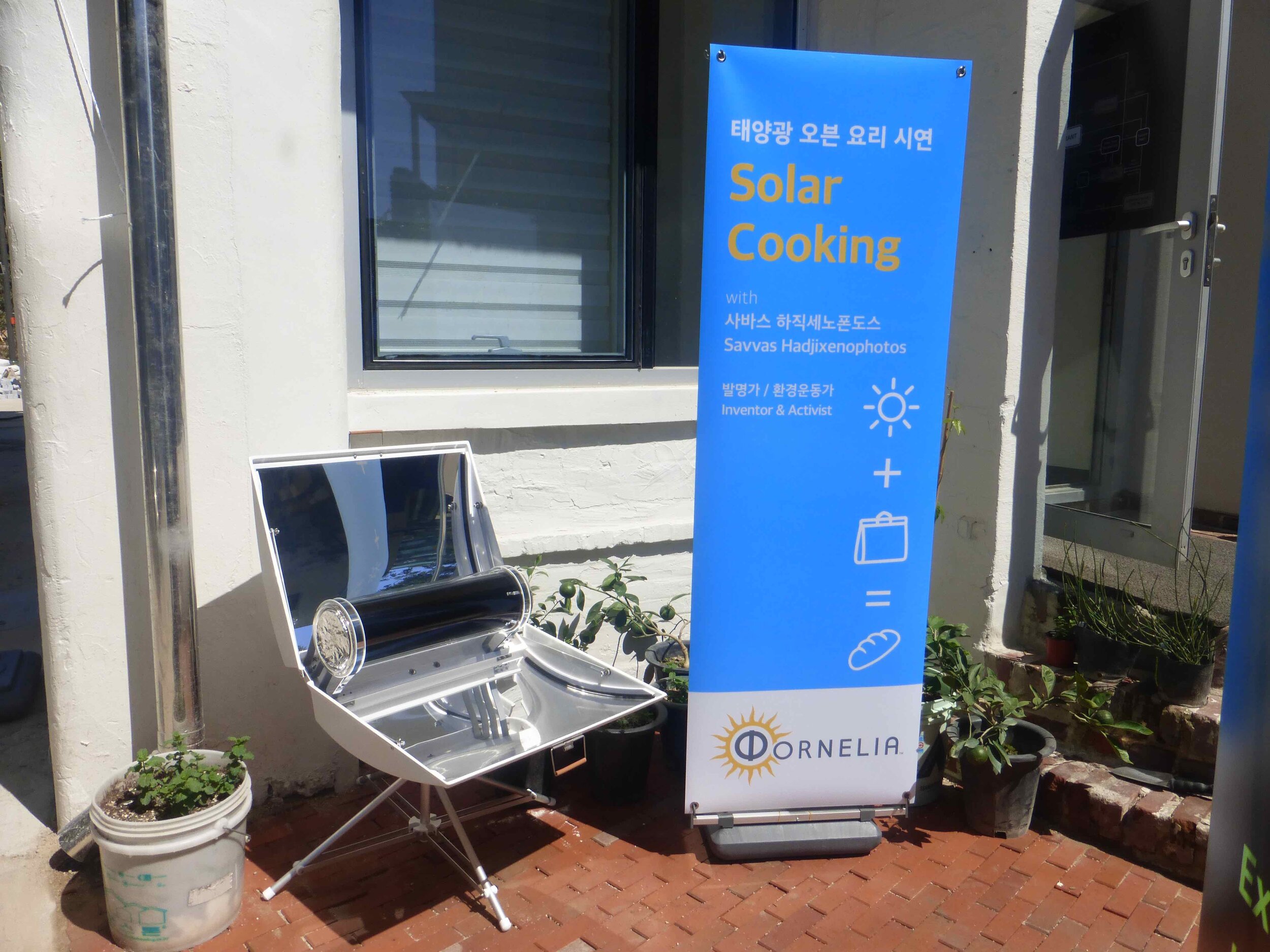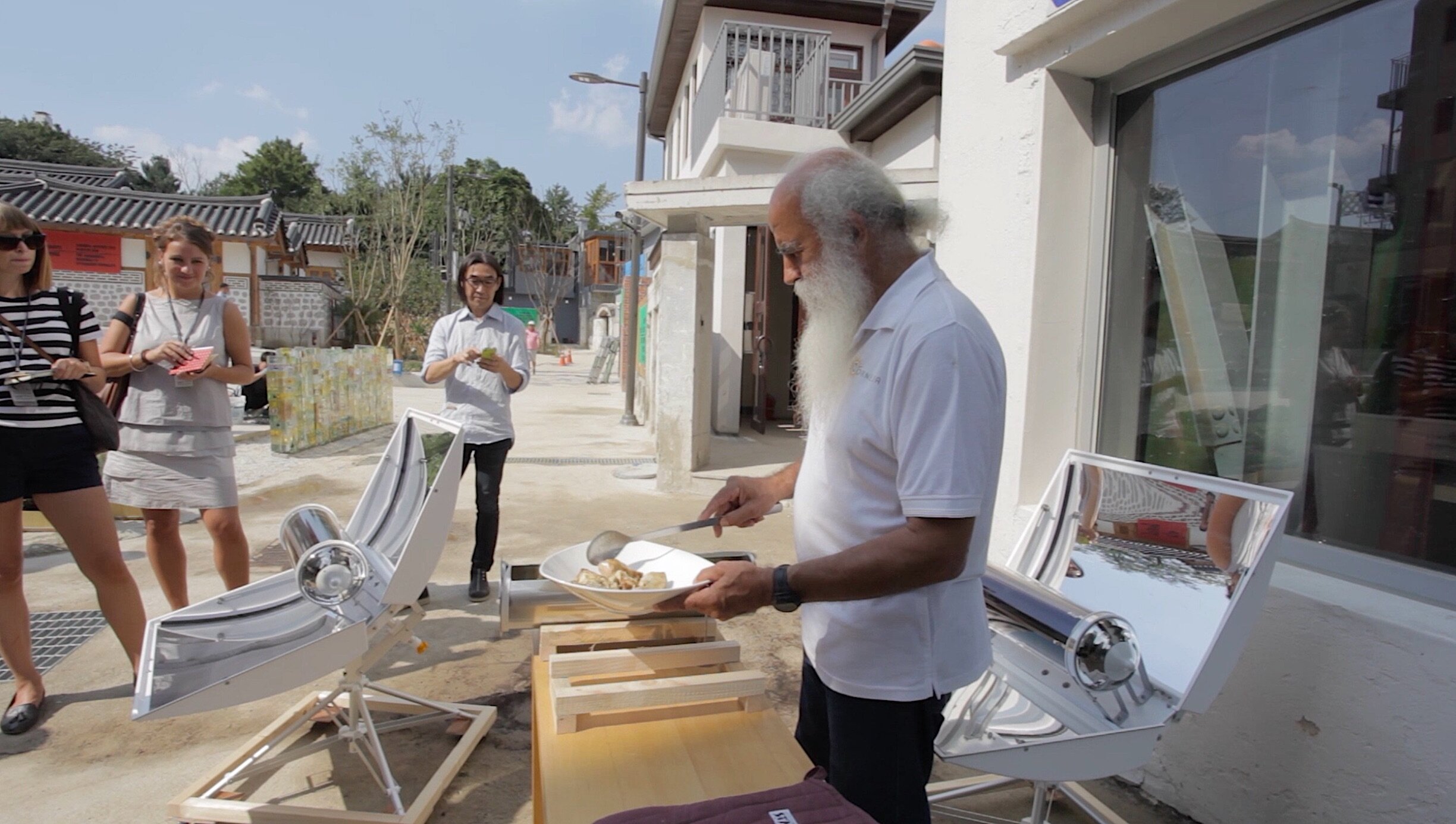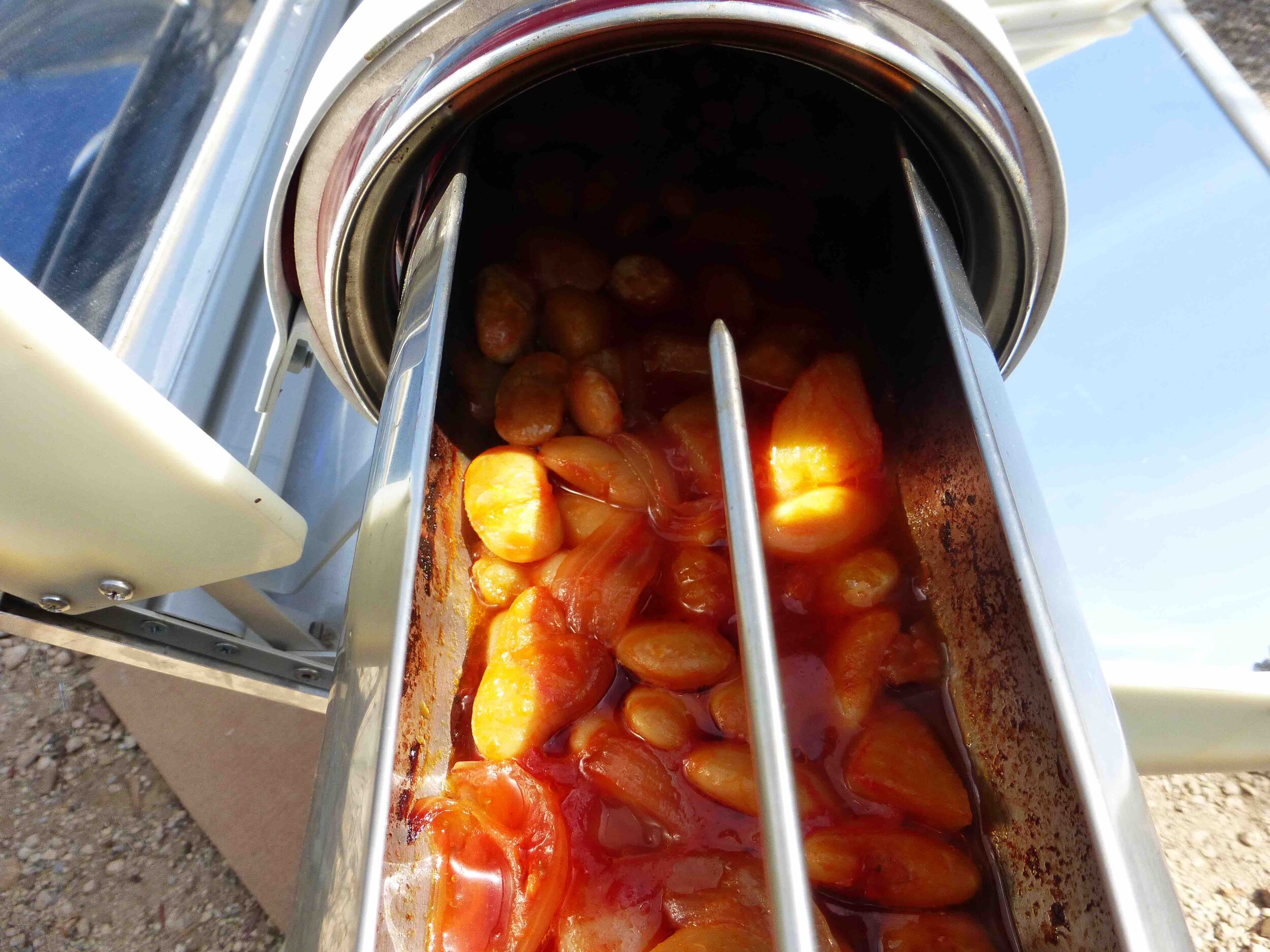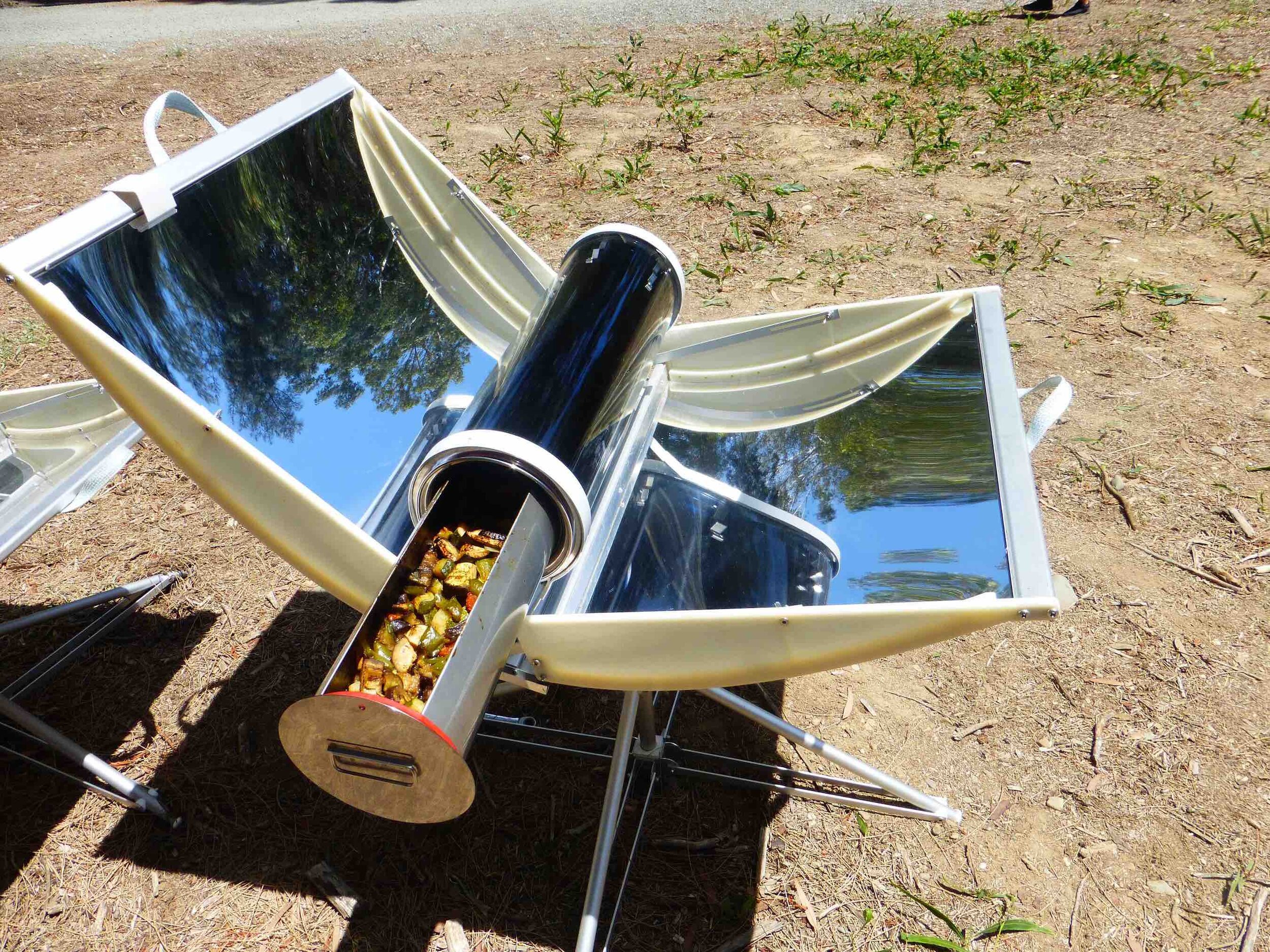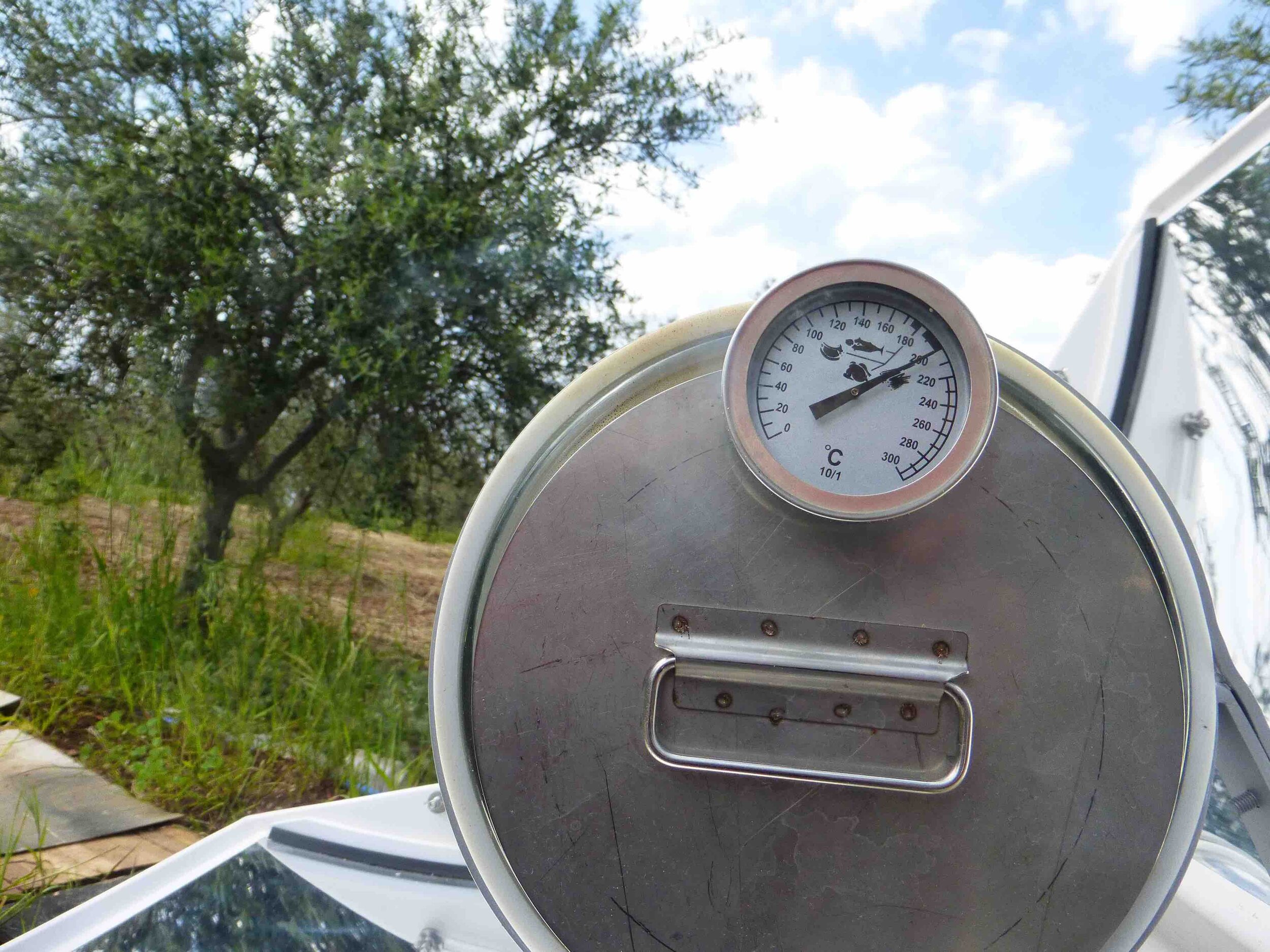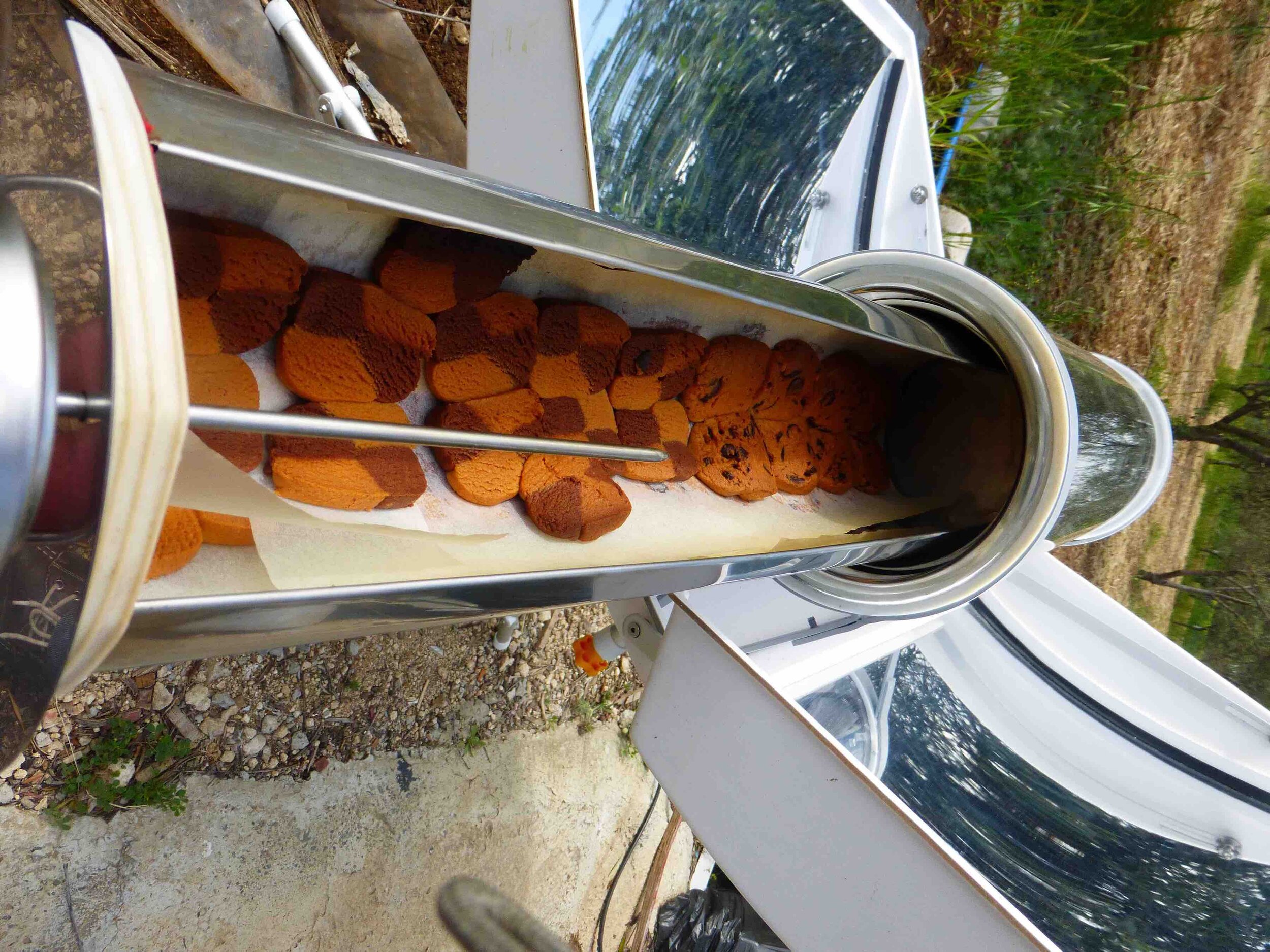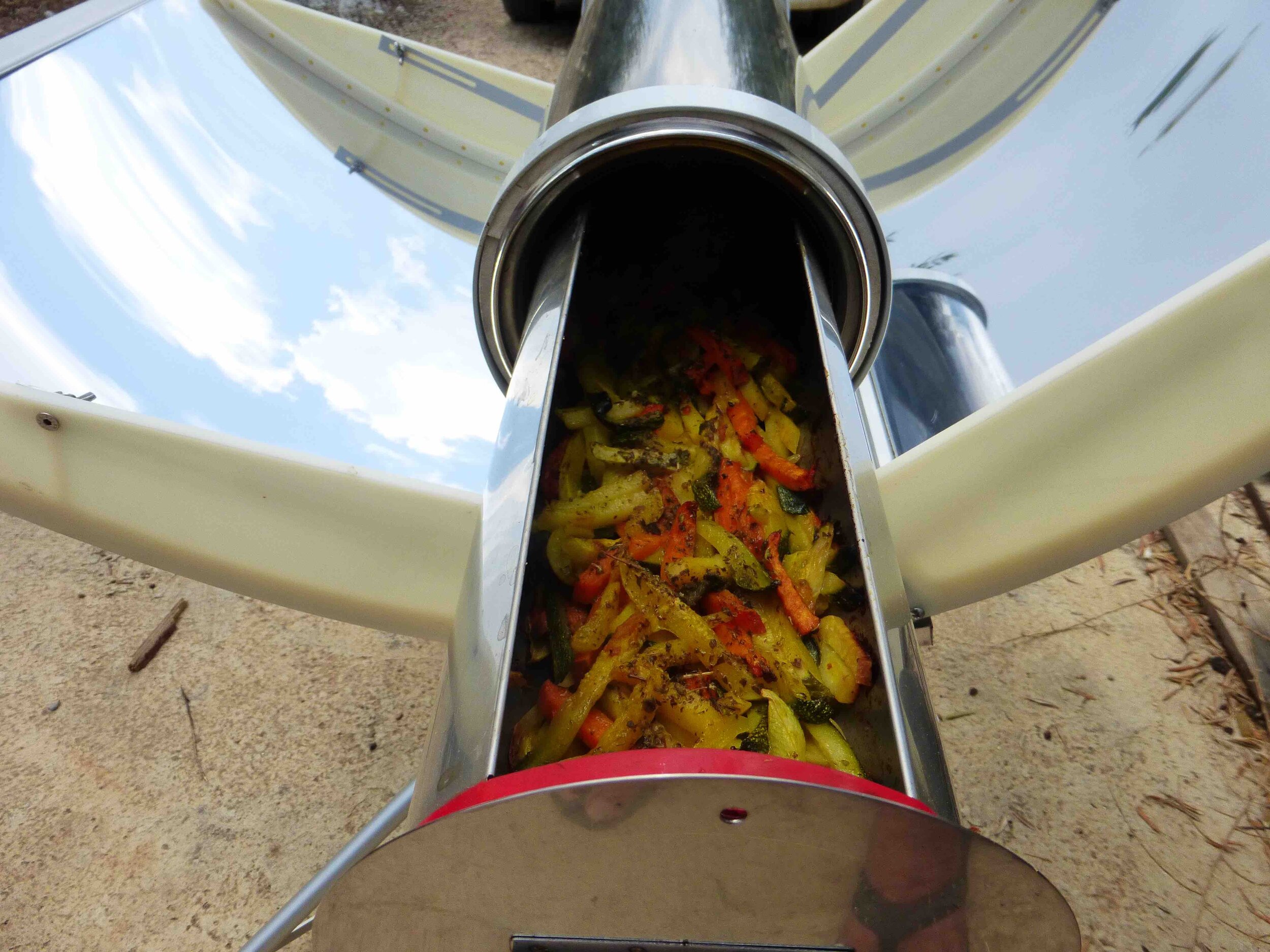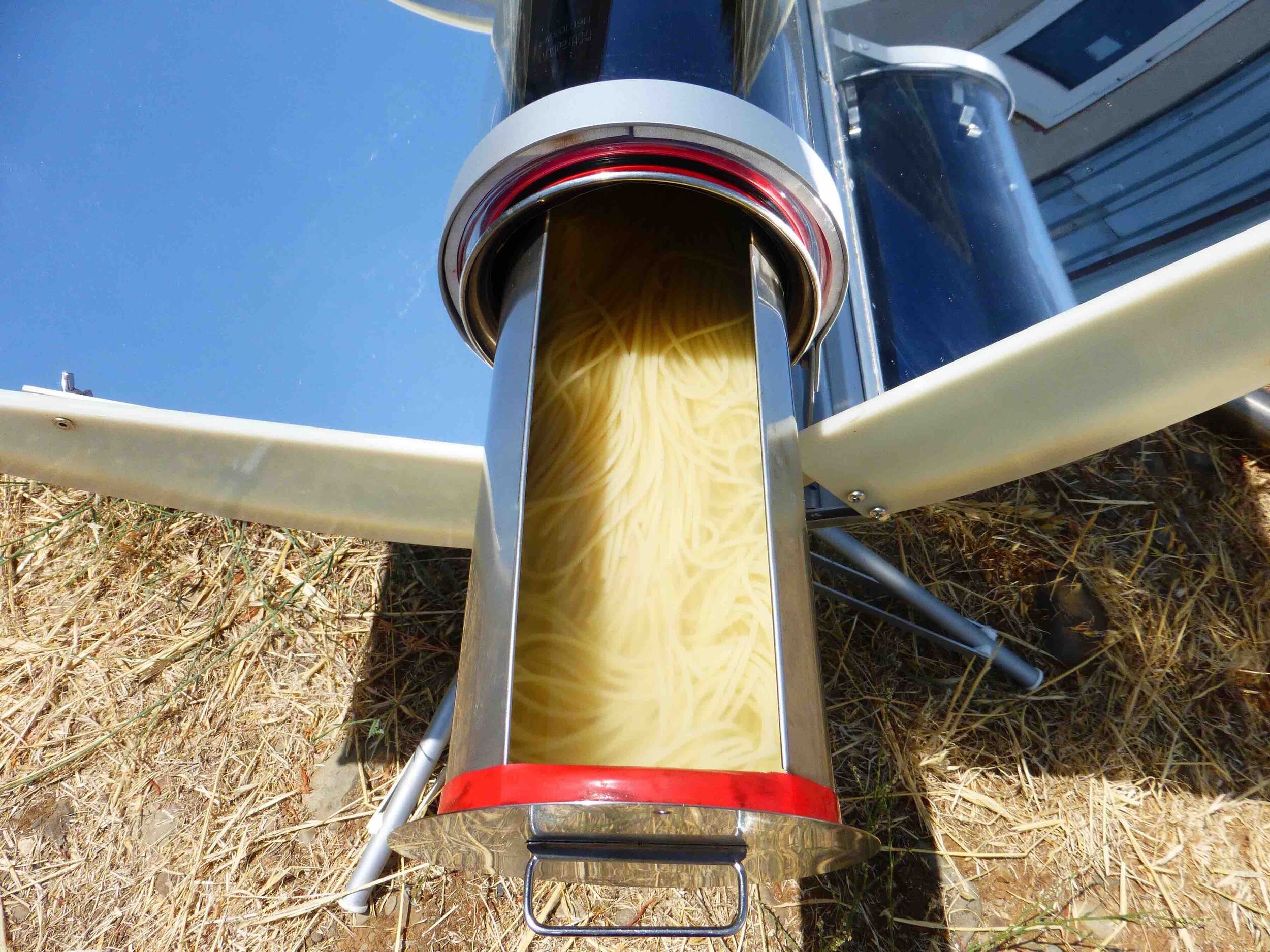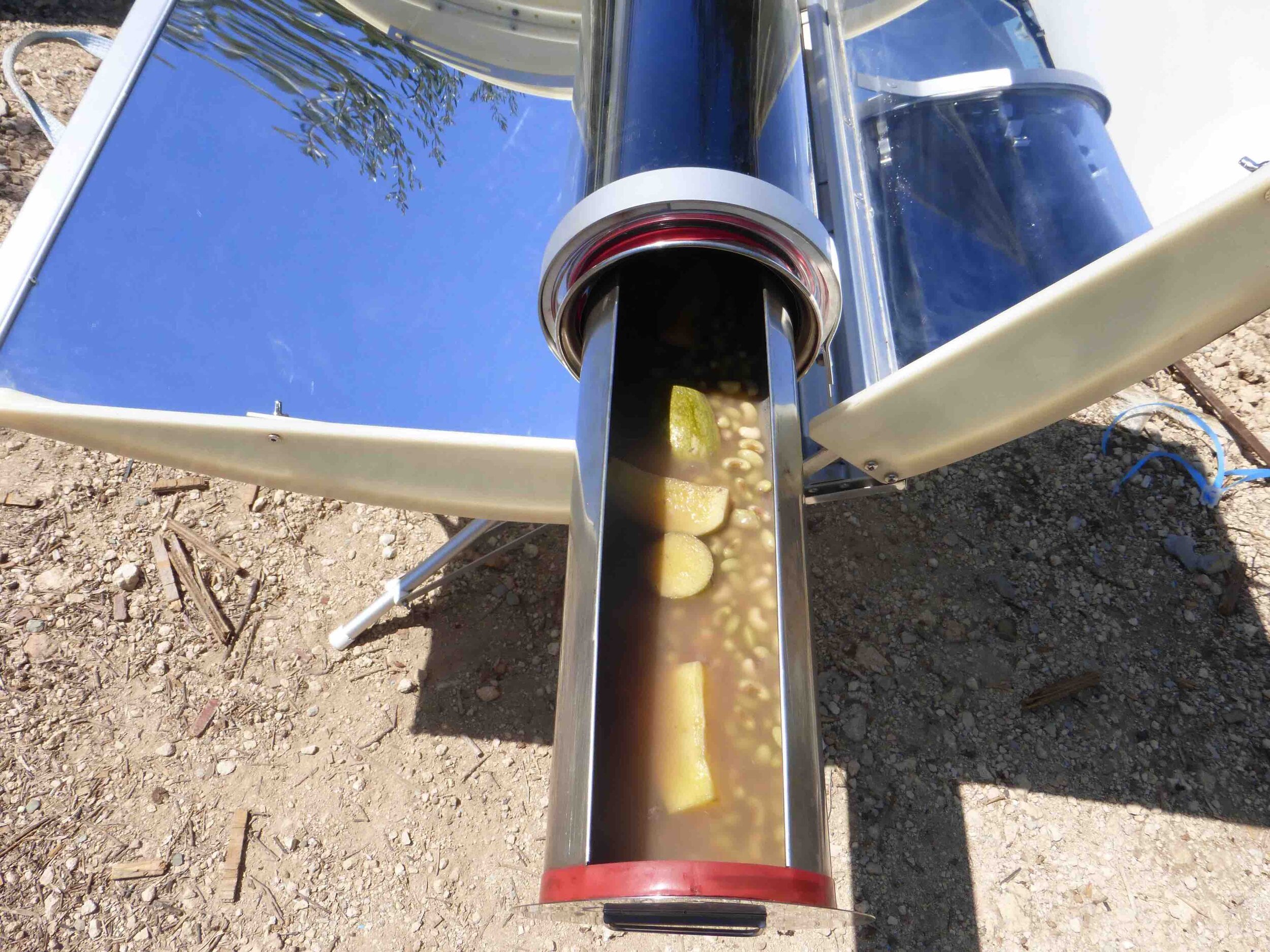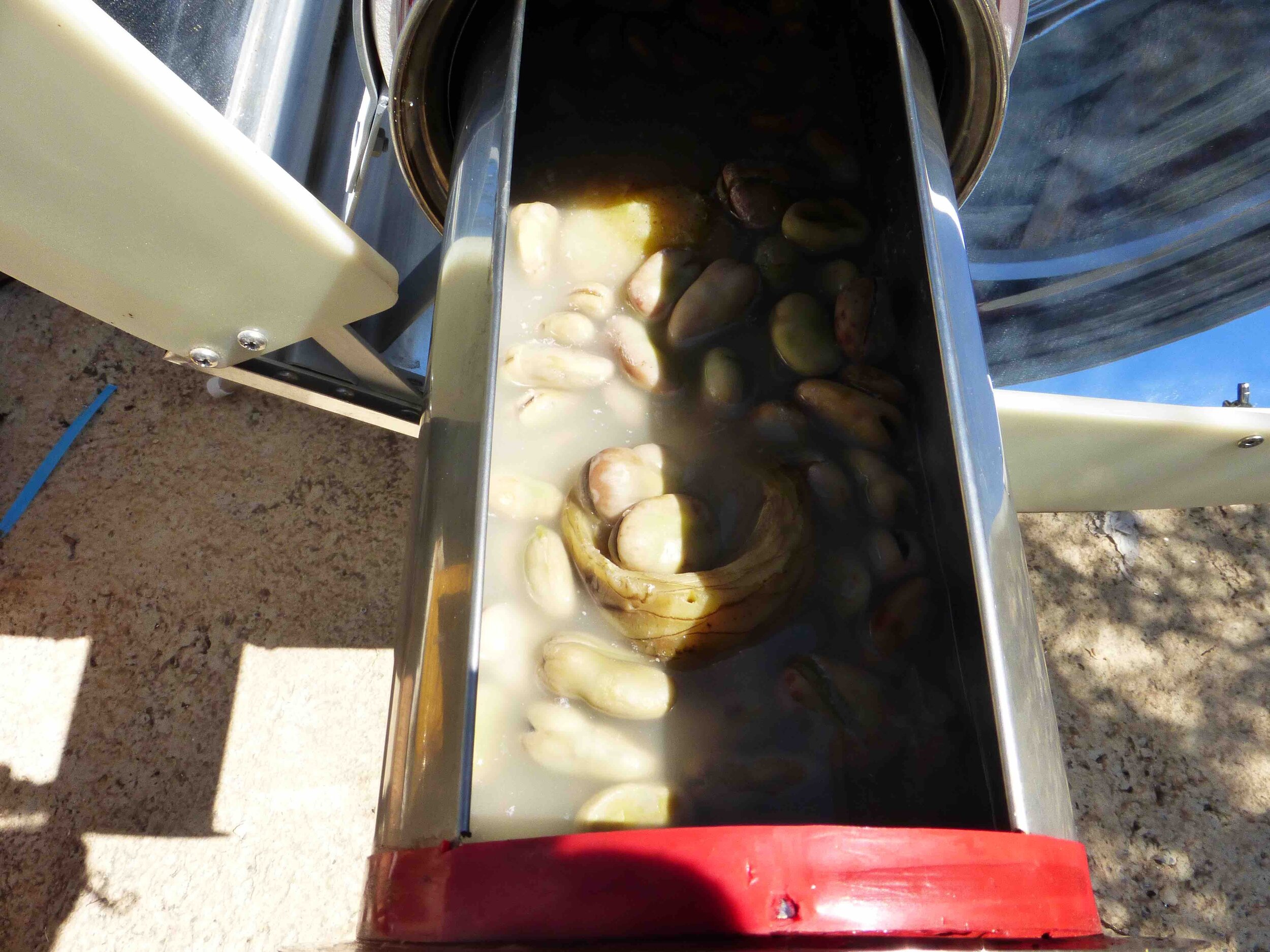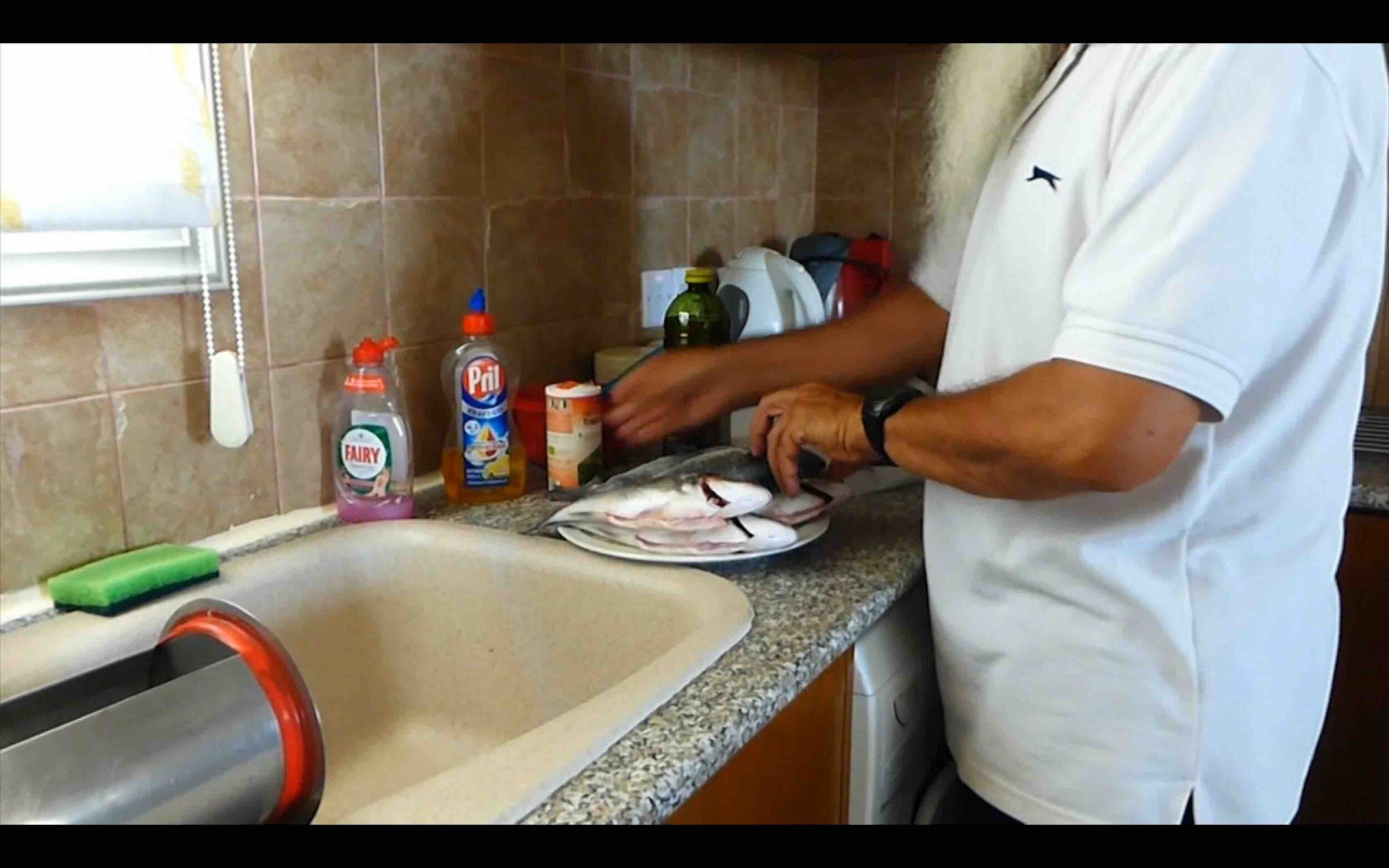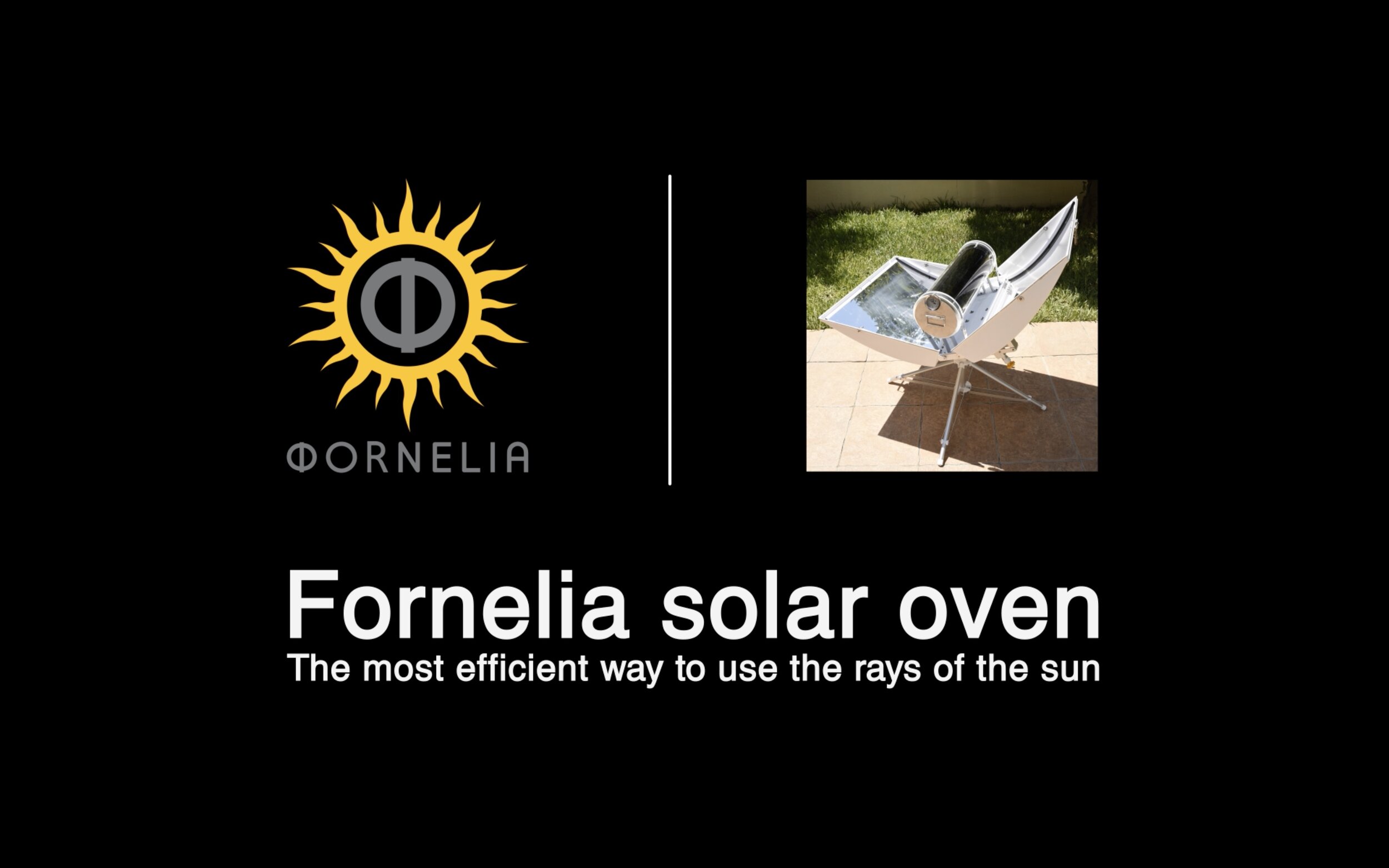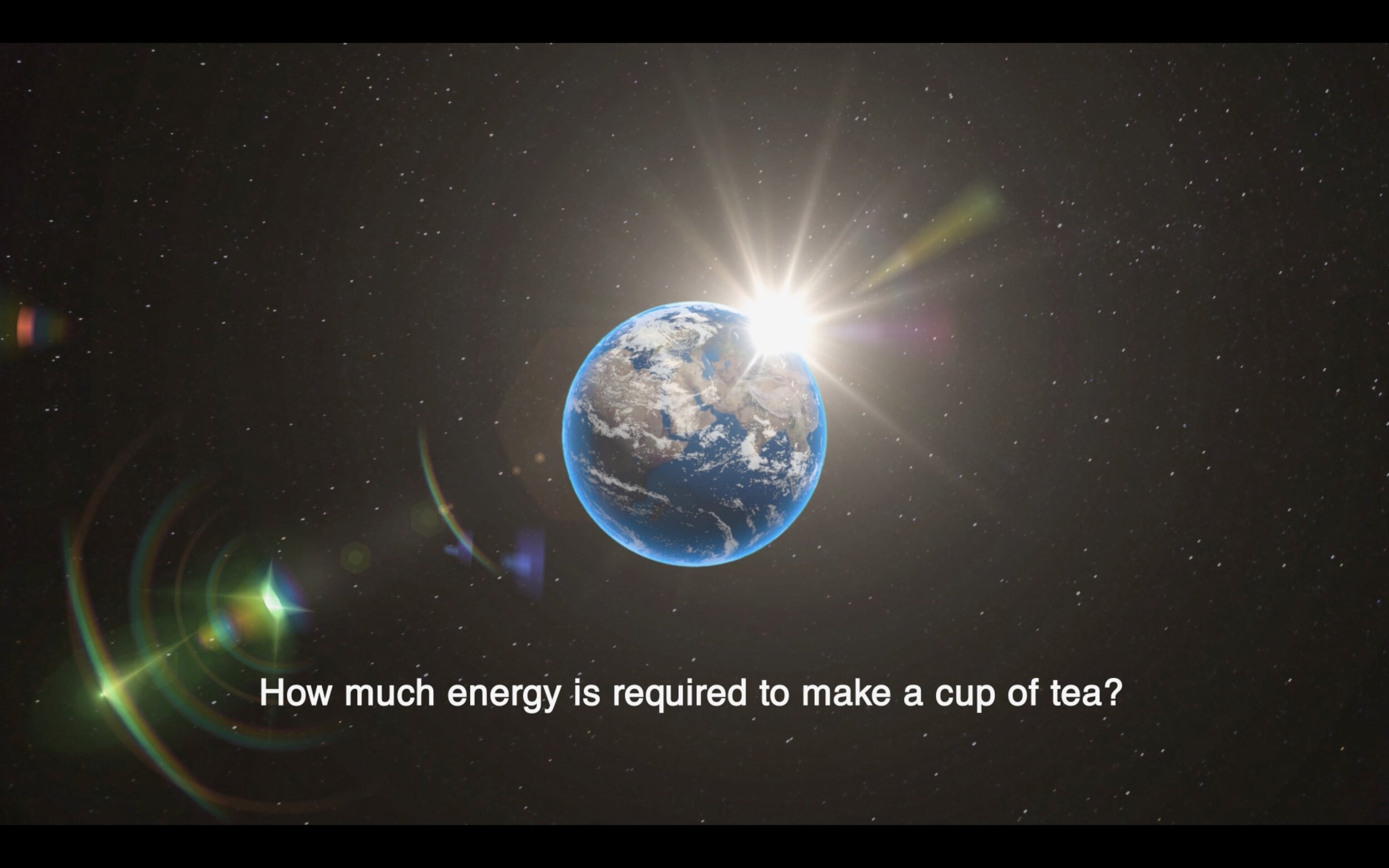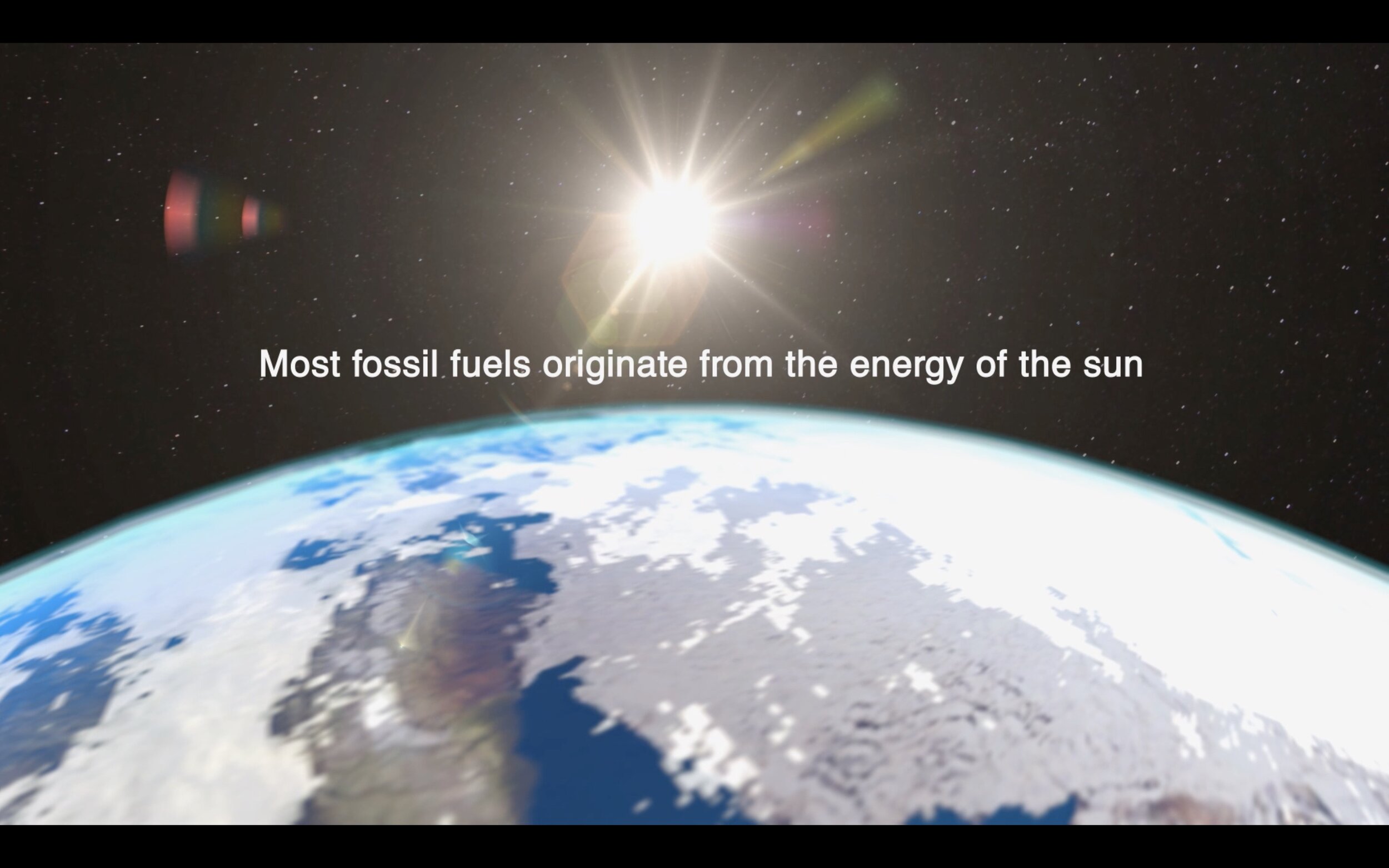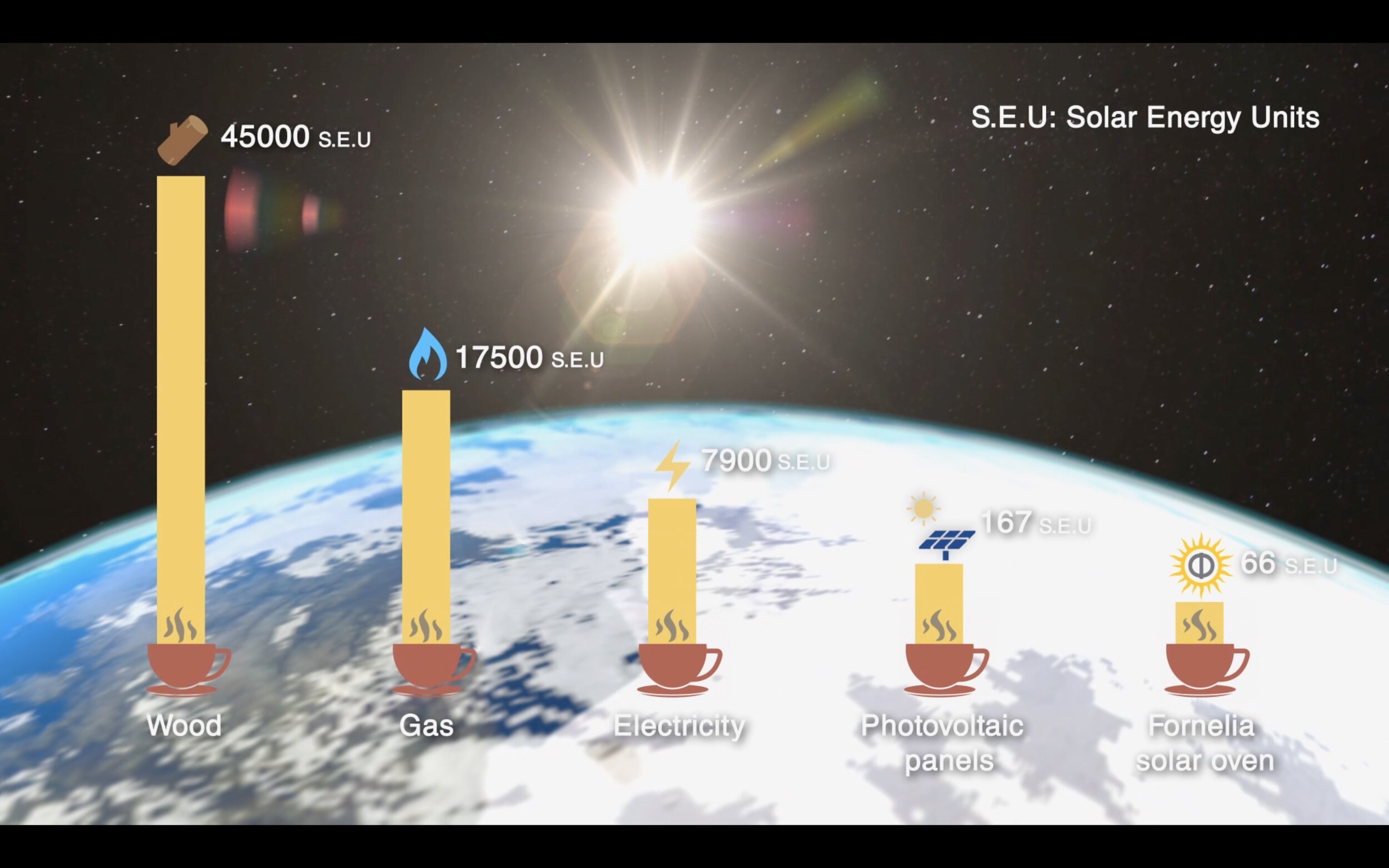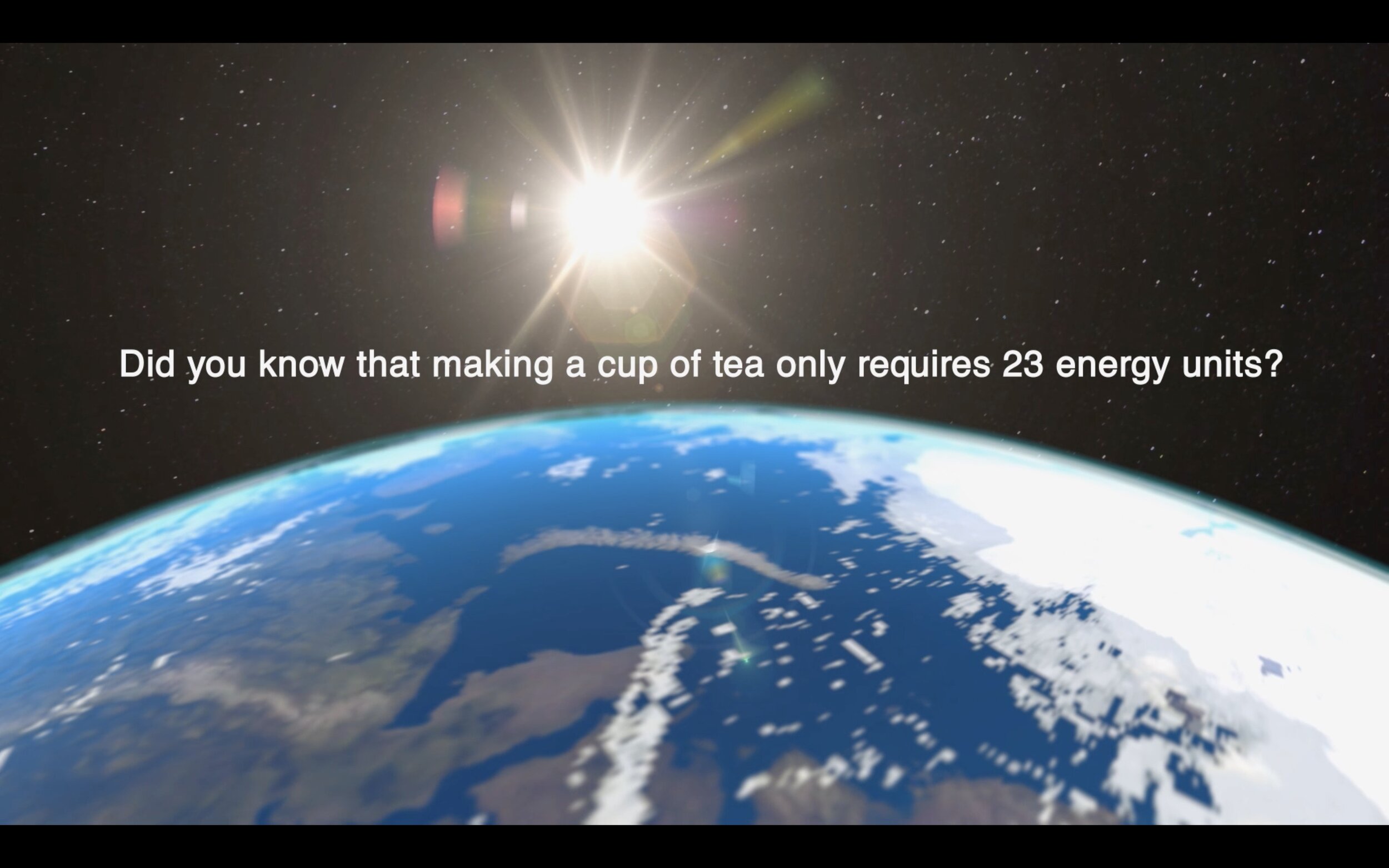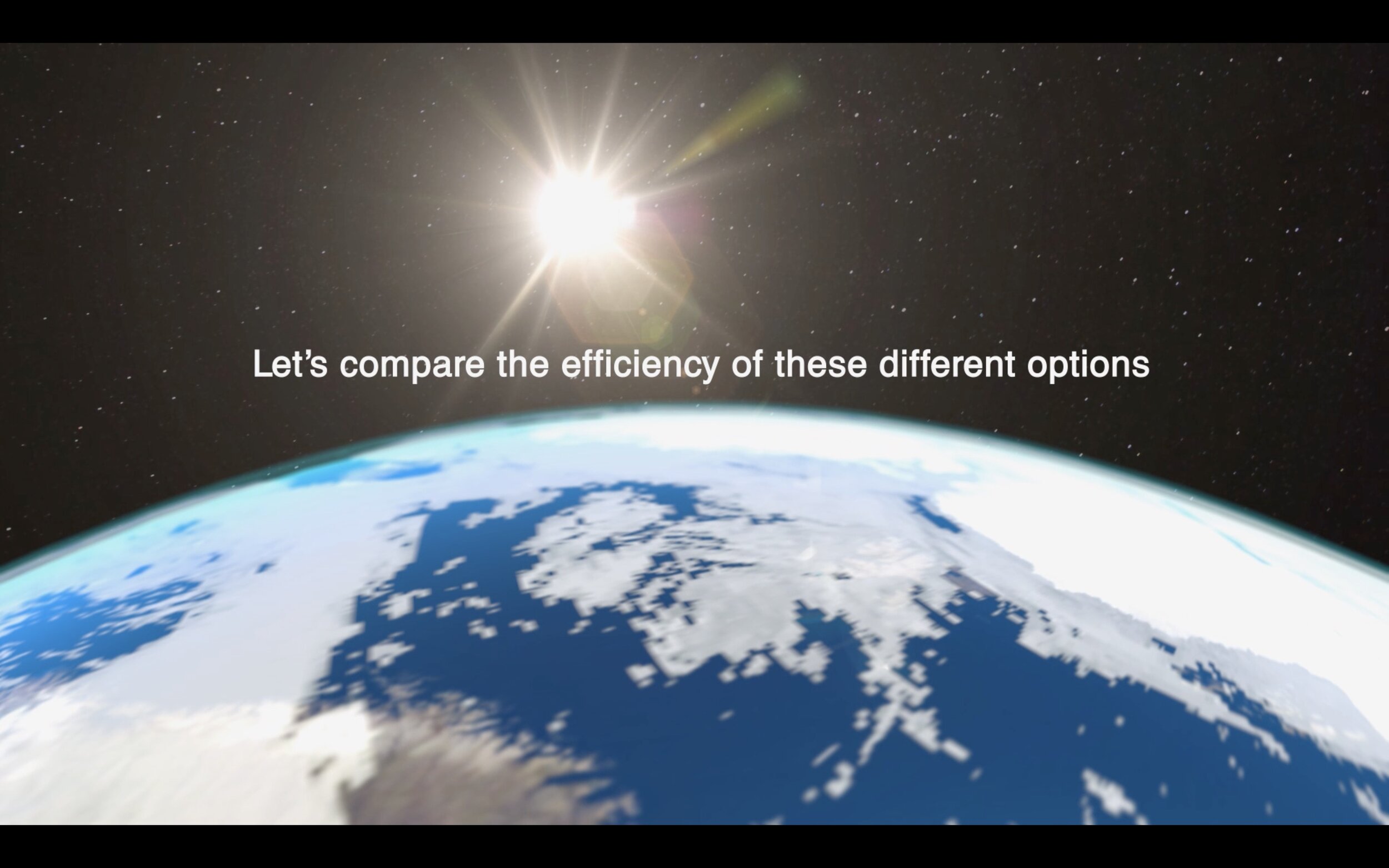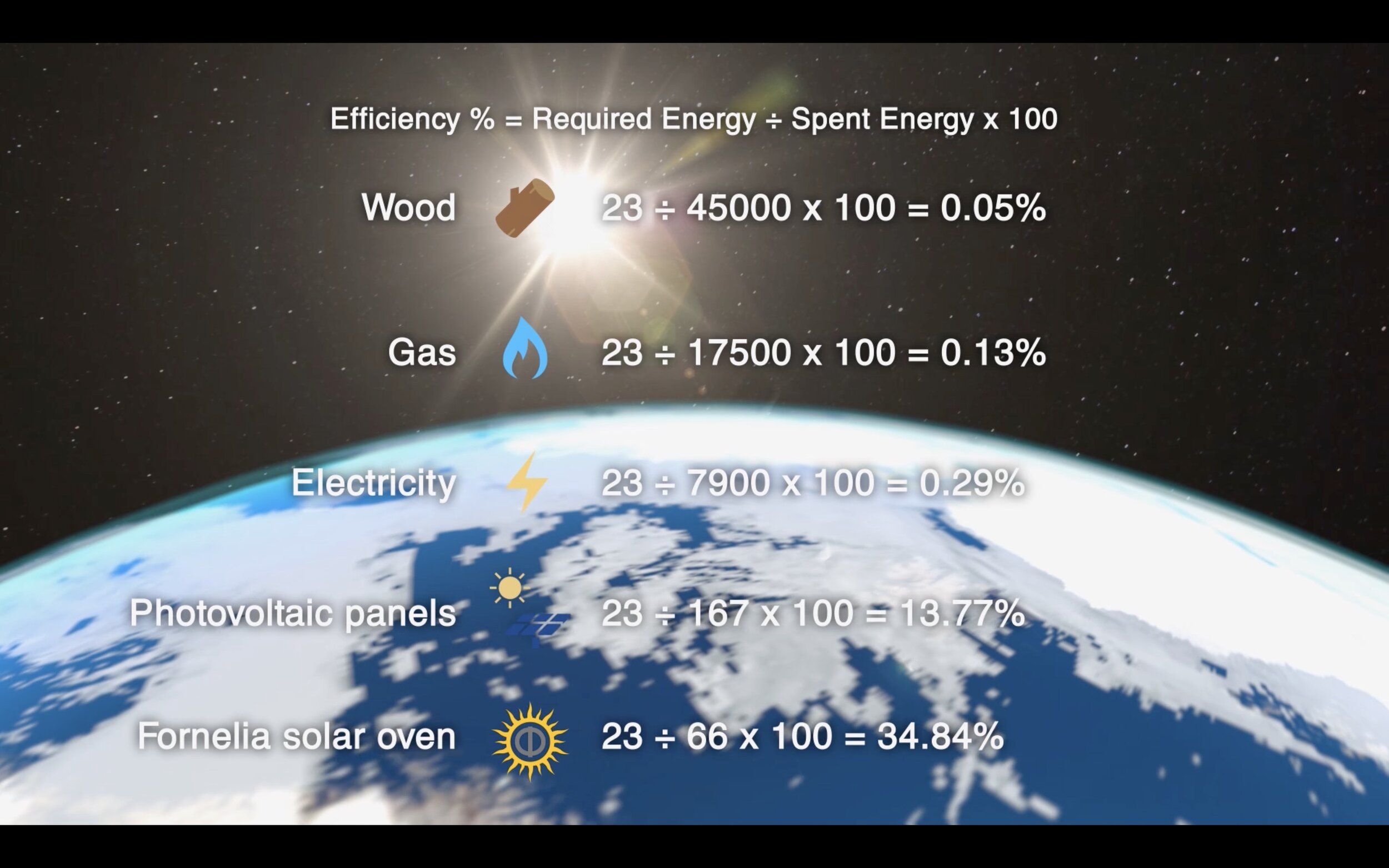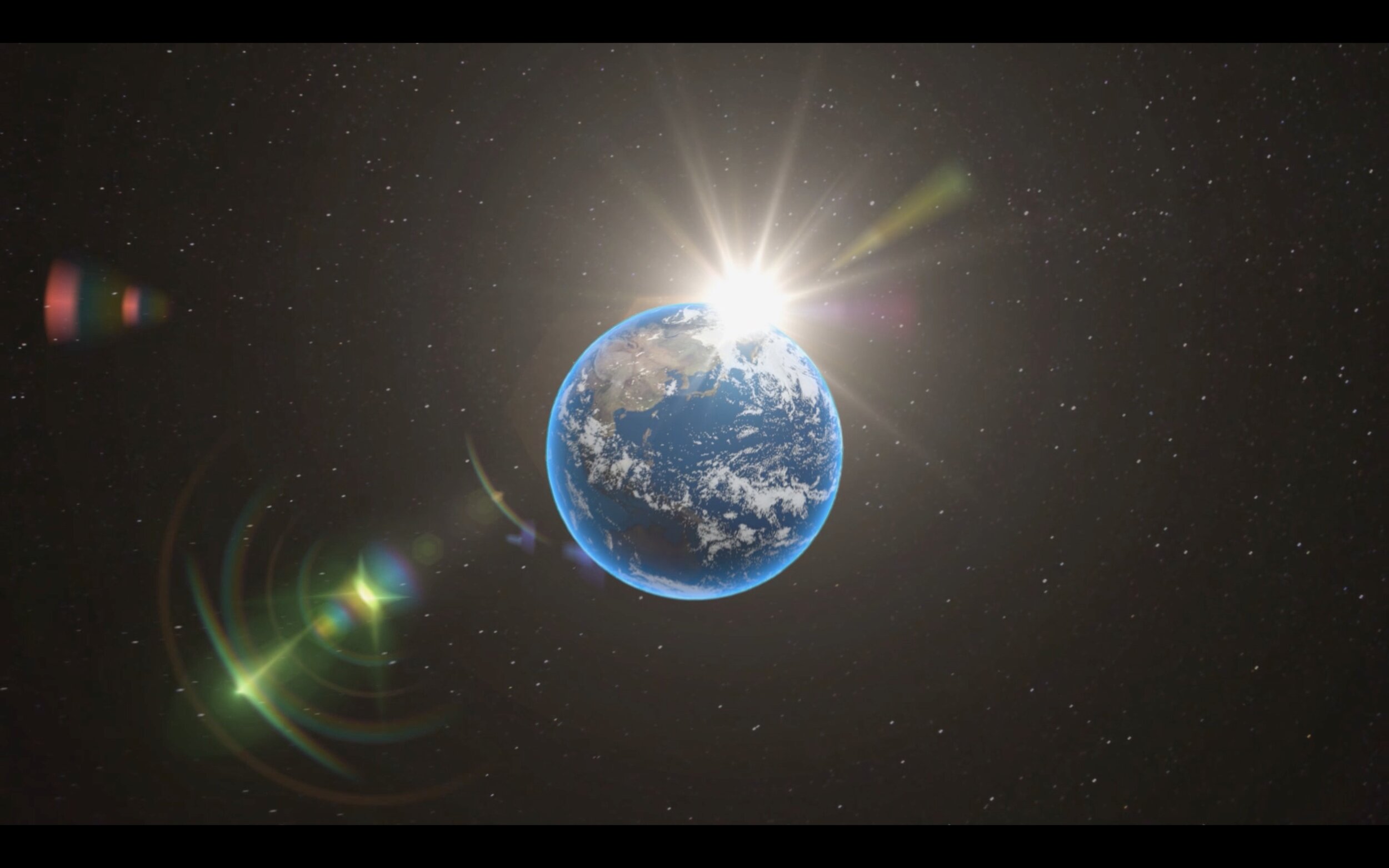Savvas Hadjixenophontos participated in the Seoul Biennale as part of ACTIVATE’s live Urban Foodshed presentations with a daily demonstration of solar cooking with his Fornelia portable solar oven; he also presented a talk “Harnessing Solar Energy for Cooking our Daily Food: Saving Energy, Saving our Air, Saving our Trees”.
An electronics engineer, activist and inventor, Savvas shared his knowledge of renewable energies, and the promise of the next green energy systems that will help deal with the world’s growing energy consumption. He described new forms of energy where oil, gas and petrol no longer play a crucial role, and the new technologies that can reduce emissions and contribute to a global energy transition to a future without fossil fuels. His past work has also included using wave energy to create electric energy and even to desalinate water.
At the Urban Foodshed
Over the course of three weeks at the Urban Foodshed, Savvas demonstrated for the public of the Biennale, solar cooking with the innovative and portable version of the Fornelia oven. Respecting the environment, this solar cooker requires only the energy of the sun, and can cook anything including meat, vegetables, even bread, through a process that is a healthier cooking method than traditional ovens, wood burning etc.
The objective of his solar oven is to harness the rays of the sun - a green renewable energy solution - for the daily cooking of food.
The cooker can be used by over 80% of the world’s population, and year-round in the EM/MENA region.
Ongoing presentations of solar cooking, and the talk “Harnessing Solar Energy for Cooking our Daily Food: Saving Energy, Saving our Air, Our Health, and Saving our Trees”.
Some background on renewables
In the face of depleting fossil fuel energy reserves around the world, rising population trends, and the increasing unprecedented economic, social, demographic and cultural changes - as well as the worsening impacts of climate change and increasing biodiversity loss - the importance of renewable sources of energy has become a matter of survival for humanity. Despite the obvious need for sustainable development across all fields, the world is still behind in implementing a sustainable way of using energy resources although solar energy is a viable alternative for all the world’s power needs; the sun in fact can provide the earth in one and a half days, energy that is equivalent to all the earths’ ultimate recoverable resource of oil energy. (Crabtree & Lewis). In other words, the sun is an unlimited clean source of energy that still remains underutilized around the world. Solar energy is also a solution to a daily energy consumption practice of all human beings - that of cooking food.
Meanwhile, women are carrying wood everywhere in Sub-Saharan Africa.
Three billion people all over the world gather and burn wood to cook their meals. As population increases, forests are fast depleting and carbon emissions rise. And the sun shines on.
Throughout the world 3 billion people use wood and charcoal to cook everyday, which can add up to 16 million tons of CO2 per meal. The perpetual use of traditional fuels like firewood, cattle dung and agro-waste burnt in traditional stoves also cause devastating deforestation, land degradation and increasing impact on changes in our climate, as the cutting and burning of trees not only emits CO2, but also reduces the amount of CO2 that can be absorbed by a forested area.
In addition to this, both carbon emission and household air pollution are leading to an increase in health problems and reduction in life expectancy in many parts of the world. Another added use of the solar ovens is as a result of the high temperatures they can produce, these ovens can pasteurize water to kill all pathogenic micro-organisms, especially important for countries where water is polluted and communicable infectious diseases are on the rise.
Savvas built his first solar oven in 1983, after returning to Cyprus from his studies in Electronic Engineering in Grenoble, France. In 2006, the documentary “An Inconvenient Truth” sparked his desire to mass produce solar ovens. Today, his aim is find the best way possible to harness this energy for the benefit of mankind through this affordable green renewable energy solution, to help improve standards of living, and to promote self-reliance through reducing dependency on carbon-based fossil fuels.
With his invention, Savvas aims to change the current reality that the number of users of solid cooking fuels in inefficient traditional stoves has remained almost the same globally for the last 3 decades; by creating a simple and “improved cooking stove” which has been such a challenge for the world, he can offer a solution with “Zero emissions, Zero running cost, Zero preparation time”.
“My vision for Fornelia is to provide sustainable, renewable energy at affordable prices throughout the world, contributing to a significant reduction in greenhouse gas emissions, and increasing the quality of life for millions of human beings. We aim to invest our profits in the design, development, and production of other innovative products that improve energy efficiency.”
Clean Cooking: The number of users of solid cooking fuels in inefficient traditional stoves has remained almost the same globally for the last 3 decades; an “improved cooking stove” has been such a challenge for the world.
Although there do exist better and more efficient ‘burning stoves’ in the world, that type of cooking cannot really be considered real clean cooking. When one burns wood, or any other fuel efficiently, the only gain is that the smoke is less, but the CO2 and other toxic gasses are still there even if one cannot see them.
It is just an illusion that wood stoves or other solid or liquid fuel are clean. The chemical reaction of burning organic fuel always produces emissions of toxic gasses and CO2. Wood is not only pure carbon, but many other dangerous elements can be present, depending of the type of wood.
According to Savvas, behind the promotion of wood stoves is that there is a big market not only for the stoves but for the fuel. This is the real reason investors invest in these kinds of cooking equipment because there is currently an income from selling fuel. Such investors are not looking at the good of the people.
It is true that it may actually be more dangerous if one cooks in a closed room believing that there are no toxic gasses. CO and CO2 are always a by-product of burning and CO can cause death. Other gases that are extremely dangerous are dioxins, a group of highly toxic chemical compounds that are harmful to health.
The only real and attainable Clean Cooking today can be by using direct solar thermal energy .
Some interesting technical information
During the last ten years Savvas has developed many different models with different methods of harnessing solar thermal energy including parabolic dishes, parabolic troughs and designs using a Fresnel lens. He also tested different ways of transferring heat energy, such as hot air, hot oil, and direct heating of the oven. The biggest challenge was the design and manufacture of the parabola at a reasonable cost without compromising quality while ensuring a long lifespan. The tracking mechanism was also a challenge since the solar oven has to follow the sun to be efficient.
Although there are a vast array of solar ovens in terms of types and models, most of them have very low efficiency and therefore need a lot of time to cook a meal. Furthermore, they have limited space capacity and not enough to satisfy the needs of a family. The materials used for many of these ovens are usually of low quality, making them unusable even after a few uses and in some cases, continued use can prove unhealthy in sanitary terms. Their efficiency, in terms of heat-absorption and heat-conservation can also be non-optimum, they can be heavy, lack mobility in terms of rotation, expensive, difficult to assemble or be made in such a way that replacement parts are unaffordable in terms of been economically pointless.
The Fornelia Solar Oven is a high-efficiency solar parabolic trough cooker. The mini model has advantages over conventional ovens. It is efficient, high-performing, 100% green, portable, safe and affordable. The Fornelia creates enough power to cook at the same ratio as common gas, or electric ovens. However, in conventional ovens, Savvas explains, most energy is lost. A conventional oven has a nominal power of 3,000 Watts. By comparison, the Fornelia Mini has a nominal power of only 300 Watts, but it can cook any meal in the same time so it is 10 times more efficient. Put differently: for every 1,000 users, the collective electricity saving is 3,000,000 Watts! The reason for this incredible performance is that the Fornelia Mini is extremely well insulated. It absorbs solar energy and keeps it without losses because internal and external compartments are separated by a vacuum which does not conduct heat. One can even use it at very low ambient temperatures, and one can cook for 8+ people or only for one person without wasting energy.
Another important element of Fornelia is the completely safe to use. The inside of the aluminum cylinder has a temperature beyond 300 degrees, yet one can touch the outside of glass without any risk of scalding and place their hand in front of the focal without risk, while the temperatures used cannot cause fire ignition by accident. The stationary model of the Fornelia can cook for up to 50 persons in one cooking session!
Conventional cooking in large parts of the MENA region is being done by burning of petroleum, wood and/or charcoal. Using solar cooking instead of conventional methods provides a most effective and highly environmentally desirable way of preparing food in urban or rural settings in this region, for street vendors, and especially for desert-dwelling populations. The many benefits of such an alternative include: reducing use of on carbon-based fossil fuels, enhanced air quality by avoiding exhaust from fuel burning, a more sustainable use of natural resources and reduced risks to human health, preventing damaging forest ecosystems and the bio-diversity of species depending on these ecosystems.
Read the text of the voice over for this animation video we made for the CBD Cop14:
Bye-bye Fuels: The Efficiency of Solar Energy for Cooking
“Most fuels, whether solid, liquid or gas, whether renewable or not, originate from the energy of the sun. The beginning of this process is photosynthesis. Fossil fuels were originally created from the decomposition of organic matter.
However, the average efficiency of the process by which all species of plants and algae transform incoming energy from the sun into usable energy through photosynthesis is only 1% ! Considering that gas and petrol were formed by the decomposition of phytoplankton over long periods of time, this 1% does not include the energy expended for collecting, refining, storing and distributing solid, liquid and gas fuels for our present needs. It is easy to appreciate that the overall efficiency is less than 1%, if all the steps of the process were accounted for !”
“To illustrate this fact with something very tangible, let's consider what happens when we make a cup of tea. Did you know that to raise the temperature of 250 ml of water from room temperature (around 20° C) to 100° Celsius, approximately 23 Watt hours of energy is needed?
Translating this into money and considering that 1 kWh costs around 20 cents, a cup of tea should cost around 0.45 cents! Do you know how much it really costs?”
“The energy needed by conventional fuels to make a cup of tea is by far greater than the real energy necessary. To heat for example a cup of water on a 1500 W gas stove it takes around 7 minutes and requires about 175 Wh. This is more than 7 times greater the actual energy needed, which is 23 Wh. This translates into a waste of 87% of the energy used, simply disappearing into thin air! So where did the 87% of this energy go? It turns out that “disappears into thin air” isn’t just a manner of speech in this case. Indeed, this is heat energy that is completely lost to the environment. If we reconsider the calculations, the solar energy originally required to produce 175 Wh of gas was 17,500 Wh, so the overall efficiency of using this method to make tea, is 0.13%.
A very common and frequently used form of energy is wood. Using wood to make a cup of tea, 100 g are needed to generate up to 450 Wh. Recall that wood was also produced through photosynthesis. The 100g of wood took in 45,000 units of solar energy to be formed. Therefore, for making a cup of tea the overall efficiency using wood is 0.05% !
What about using an electric kettle to make that cup of tea? Using a very good 1800 W electric kettle, with insulated walls that minimize heat losses, it takes about 1 minute, equivalent to 30 Wh, to heat 250 ml of water. That sounds good; it’s pretty close to the 23 Wh that goes directly to heating the water! However, we have to recall the beginning of the energy transformation chain, and the original energy from the sun. The efficiency of conventional power stations that produced the electricity from fossil fuel sources is around 38 %. So, in order to produce the 30 Wh that the kettle requires to boil a cup of water, it actually consumed 79 Wh of these fuels. The 1% efficiency of photosynthesis, translates to having used 7,900 Wh of solar energy…so the kettle’s efficiency is in actual fact only 0.29%!
So how much does it cost to make a cup of tea?
What if we were to bypass fossil fuels altogether? Solar photovoltaic panels are more efficient than photosynthesis at transforming solar energy into usable forms. Their efficiency is around 18%, which, translates to using 167 Wh of solar energy to get the 23 Wh necessary to make a cup of tea, thus 13.8%
Although it is much more efficient than any fossil fuel source, it is also clean and renewable. But it is still a very expensive solution, as only 13.8% of the solar energy needed to heat a cup of tea actually goes to heating the cup of tea, the rest of it is lost to the environment !
We have seen here that solar energy comes to us in many forms and with the Fornelia solar oven, we intended to find the best way possible to harness this energy for the benefit of mankind. Our oven relies on the sun and therefore it can be used by over 80% of the world’s population and about 30% of this population has sun all year long.
The solar oven takes 8 minutes of sun energy, or 66.6Wh of solar energy to heat 250 ml of water from room temperature to 100° Celsius. As there are no transformations of energy in between, this results in a total efficiency of 23/66.6 = 34.5%! This is a clean and renewable energy solution that comes directly from the sun.
The oven can be used in homes, camping sites, eco-farms that can offer a fully environmental experience, businesses and in-house cafeterias that see the benefit of having an eco-friendly oven always at the ready. And high efficiency translates into performance that rivals both gas and electric stoves, with food cooking times that are directly comparable and food that comes out delicious and steaming hot!
Our thanks to Savvas for sharing his time and knowledge, especially in Korea, and also for cooking for so many people, residents of Seoul and international visitors!

